Time-Domain Investigations of Coherent Phonons in van der Waals Thin Films
Abstract
1. Introduction
2. Mechanical Properties of van der Waals Materials
2.1. Raman-Active Phonons
2.2. Phonon Dispersion
2.3. Static and Dynamical Stress
2.4. Mechanical Parameters
3. Time-Domain Acoustic Investigations
3.1. Generation of Coherent Phonons
3.2. Excited Modes and Detection Scheme
4. Coherent Phonons in vdW Materials
4.1. Electronic and Thermal Relaxation
4.2. Coherent Optical Modes
4.3. Propagative Coherent Acoustic Phonons
4.4. Resonant Coherent Phonons
4.5. Van der Waals Transducers
4.6. Non-Optical Probes
5. Conclusions and Perspectives
Author Contributions
Funding
Conflicts of Interest
References
- Fong, C.Y.; Schlüter, M. Electronic Structure of some layer compounds. In Electrons and Phonons in Layered Crystal Structures; Wieting, T.J., Schlüter, M.D., Eds.; Reidel Publishing Company: Dordrecht, The Netherlands, 1979; pp. 145–315. [Google Scholar] [CrossRef]
- Wieting, T.J.; Verble, J.L. Infrared and raman investigations of long-wavelength phonons in layered materials. In Electrons and Phonons in Layered Crystal Structures; Wieting, T.J., Schlüter, M., Reidel, D., Eds.; Publishing Company: Dordrecht, The Netherlands, 1979; pp. 321–407. [Google Scholar] [CrossRef]
- He, J.; Hummer, K.; Franchini, C. Stacking effects on the electronic and optical properties of bilayer transition metal dichalcogenides MoS2, MoSe2, WS2, and WSe2. Phys. Rev. B 2014, 89, 075409. [Google Scholar] [CrossRef]
- Mas-Balleste, R.; Gómez-Navarro, C.; Gomez-Herrero, J.; Zamora, F. 2D materials: To graphene and beyond. Nanoscale 2011, 3, 20. [Google Scholar] [CrossRef] [PubMed]
- Xu, M.; Liang, T.; Shi, M.; Chen, H. Graphene-like two-dimensional materials. Chem. Rev. 2013, 113, 766–3798. [Google Scholar] [CrossRef]
- Geim, A.K.; Grigorieva, I.V. Van der Waals heterostructures. Nature 2013, 499, 419–425. [Google Scholar] [CrossRef] [PubMed]
- Miró, P.; Audiffred, M.; Heine, T. An atlas of two-dimensional materials. Chem. Soc. Rev. 2014, 43, 6537. [Google Scholar] [CrossRef] [PubMed]
- Novoselov, K.S.; Mishchenko, A.; Carvalho, A.; Castro Neto, A.H. 2D materials and van der Waals heterostructures. Science 2016, 353, aac9439. [Google Scholar] [CrossRef] [PubMed]
- Wakabayashi, N.; Nicklow, R.M. Neutron scattering and lattice dynamics of materials with layered structures. In Electrons and Phonons in Layered Crystal Structures; Wieting, T.J., Schlüter, M.D., Eds.; Reidel Publishing Company: Dordrecht, The Netherlands, 1979; pp. 409–464. [Google Scholar] [CrossRef]
- Novoselov, K.S.; Geim, A.K.; Morozov, S.V.; Jiang, D.; Zhang, Y.; Dubonos, S.V.; Grigorieva, I.V.; Firsov, A.A. Electric field effect in atomically thin carbon films. Science 2004, 306, 666–669. [Google Scholar] [CrossRef]
- Geim, K.; Novoselov, K.S. The rise of graphene. Nat. Mater. 2007, 6, 183–191. [Google Scholar] [CrossRef]
- Nair, R.R.; Blake, P.; Grigorenko, A.N.; Novoselov, K.S.; Booth, T.J.; Stauber, T.; Peres, N.M.R.; Geim, A.K. Fine structure constant defines visual transparency of graphene. Science 2008, 320, 1308. [Google Scholar] [CrossRef]
- Das Sarma, S.; Adam, S.; Hwang, E.H.; Rossi, E. Electronic transport in two-dimensional graphene. Rev. Mod. Phys. 2011, 83, 407. [Google Scholar] [CrossRef]
- Balandin, A.A.; Ghosh, S.; Bao, W.; Calizo, I.; Teweldebrhan, D.; Miao, F.; Lau, C.N. Superior thermal conductivity of single-layer graphene. Nano Lett. 2008, 8, 3, 902–907. [Google Scholar] [CrossRef] [PubMed]
- Lee, C.; Wei, X.; Kysar, J.W.; Hone, J. Measurement of the elastic properties and intrinsic strength of monolayer graphene. Science 2008, 321, 385–388. [Google Scholar] [CrossRef] [PubMed]
- Mak, K.F.; Lee, C.; Hone, J.; Shan, J.; Heinz, T.F. Atomically ThinMoS2: A New Direct-Gap Semiconductor. Phys. Rev. Lett. 2010, 105, 136805. [Google Scholar] [CrossRef] [PubMed]
- Rasmussen, F.A.; Thygesen, K.S. Computational 2D materials database: Electronic structure of transition-metal dichalcogenides and oxides. J. Phys. Chem. C 2015, 119, 13169–13183. [Google Scholar] [CrossRef]
- Radisavljevic, B.; Radenovic, A.; Brivio, J.; Giacometti, V.; Kis, A. Single-layer MoS2 transistors. Nat. Nanotechnol. 2011, 6, 147–150. [Google Scholar] [CrossRef]
- Raja, A.; Chaves, A.; Yu, J.; Arefe, G.; Hill, H.M.; Rigosi, A.F.; Berkelbach, T.C.; Nagler, P.; Schüller, C.; Korn, T.; et al. Coulomb engineering of the bandgap and excitons in two-dimensional materials. Nat. Commun. 2017, 8, 15251. [Google Scholar] [CrossRef]
- Fratini, S.; Guinea, F. Substrate-limited electron dynamics in graphene. Phys. Rev. B 2008, 77, 195415. [Google Scholar] [CrossRef]
- Seol, J.H.; Jo, I.; Moore, A.L.; Lindsay, L.; Aitken, Z.H.; Pettes, M.T.; Li, X.; Yao, Z.; Huang, R.; Broido, D.; et al. Two-dimensional phonon transport in supported graphene. Science 2010, 328, 213–216. [Google Scholar] [CrossRef]
- Freitag, M.; Steiner, M.; Martin, Y.; Perebeinos, V.; Chen, Z.; Tsang, J.C.; Avouris, P. Energy dissipation in graphene field-effect transistors. Nano Lett. 2009, 9, 1883–1888. [Google Scholar] [CrossRef]
- Dean, C.R.; Young, A.F.; Meric, I.; Lee, C.; Wang, L.; Sorgenfrei, S.; Watanabe, K.; Taniguchi, T.; Kim, P.; Shepard, K.L.; et al. Boron nitride substrates for high-quality graphene electronics. Nat. Nanotechnol. 2010, 5, 722–726. [Google Scholar] [CrossRef]
- Yankowitz, M.; Xue, J.; Leroy, B.J. Graphene on hexagonal boron nitride. J. Phys. Condens. Matter 2014, 26, 303201. [Google Scholar] [CrossRef] [PubMed]
- Castellanos-Gomez, A.; Buscema, M.; Molenaar, R.; Singh, V.; Janssen, L.; Van Der Zant, H.S.J.; A Steele, G. Deterministic transfer of two-dimensional materials by all-dry viscoelastic stamping. 2D Mater. 2014, 1. [Google Scholar] [CrossRef]
- Pizzocchero, F.; Gammelgaard, L.; Jessen, B.S.; Caridad, J.M.; Wang, L.; Hone, J.; Bøggild, P.; Booth, T.J. The hot pick-up technique for batch assembly of van der Waals heterostructures. Nat. Commun. 2016, 7, 11894. [Google Scholar] [CrossRef] [PubMed]
- Frisenda, R.; Navarro-Moratalla, E.; Gant, P.; De Lara, D.P.; Jarillo-Herrero, P.; Gorbachev, R.V.; Castellanos-Gomez, A. Recent progress in the assembly of nanodevices and van der Waals heterostructures by deterministic placement of 2D materials. Chem. Soc. Rev. 2018, 47, 53–68. [Google Scholar] [CrossRef] [PubMed]
- Wang, L.; Meric, I.; Huang, P.Y.; Gao, Q.; Gao, Y.; Tran, H.; Taniguchi, T.; Watanabe, K.; Campos, L.M.; Muller, D.A.; et al. One-dimensional electrical contact to a two-dimensional material. Science 2013, 342, 614–617. [Google Scholar] [CrossRef] [PubMed]
- Liu, K.; Zhang, L.; Cao, T.; Jin, C.; Qiu, D.; Zhou, Q.; Zettl, A.; Yang, P.; Louie, S.G.; Wang, F. Evolution of interlayer coupling in twisted molybdenum disulfide bilayers. Nat. Commun. 2014, 5, 4966. [Google Scholar] [CrossRef] [PubMed]
- Li, X.; Cai, W.; An, J.; Kim, S.; Nah, J.; Yang, D.; Piner, R.; Velamakanni, A.; Jung, I.; Tutuc, E.; et al. Large-area synthesis of high-quality and uniform graphene films on copper foils. Science 2009, 324, 1312–1314. [Google Scholar] [CrossRef]
- Chen, X.; Zhang, L.; Li, H. Large area CVD growth of graphene. Synth. Met. 2015, 210, 95–108. [Google Scholar] [CrossRef]
- Hernandez, Y.; Nicolosi, V.; Lotya, M.; Blighe, F.M.; Sun, Z.; De, S.; McGovern, I.T.; Holland, B.; Byrne, M.; Gun’Ko, Y.K.; et al. High-yield production of graphene by liquid-phase exfoliation of graphite. Nat. Nanotechnol. 2008, 3, 563–568. [Google Scholar] [CrossRef]
- Cao, C.; Xue, Y.; Liu, Z.; Zhou, Z.; Ji, J.; Song, Q.; Hu, Q.; Fang, Y.; Tang, C. Scalable exfoliation and gradable separation of boric-acid-functionalized boron nitride nanosheets. 2D Mater. 2019, 6, 035014. [Google Scholar] [CrossRef]
- Elias, C.; Valvin, P.; Pelini, T.; Summerfield, A.; Mellor, C.J.; Cheng, T.S.; Eaves, L.; Foxon, C.T.; Beton, P.H.; Novikov, S.V.; et al. Direct band-gap crossover in epitaxial monolayer boron nitride. Nat. Commun. 2019, 10, 1–7. [Google Scholar] [CrossRef] [PubMed]
- Liu, Y.; Huang, Y.; Duan, X. Van der Waals integration before and beyond two-dimensional materials. Nature 2019, 567, 323–333. [Google Scholar] [CrossRef] [PubMed]
- Ng, S.-W.; Noor, N.; Zheng, Z. Graphene-based two-dimensional Janus materials. NPG Asia Mater. 2018, 10, 217–237. [Google Scholar] [CrossRef]
- Lind, H.; Lidin, S.; Häussermann, U. Structure and bonding properties of(Bi2Se3)m(Bi2)nstacks by first-principles density functional theory. Phys. Rev. B 2005, 72, 184101. [Google Scholar] [CrossRef]
- Venkatasubramanian, R.; Colpitts, T.S.; Watko, E.; Lamvik, M.K.; El-Masry, N. MOCVD of Bi2Te3, Sb2Te3 and their superlattice structures for thin-film thermoelectric applications. J. Cryst. Growth 1997, 170, 817–821. [Google Scholar] [CrossRef]
- Chen, H.-J.; Wu, K.H.; Luo, C.W.; Uen, T.M.; Juang, J.Y.; Lin, J.-Y.; Kobayashi, T.; Yang, H.-D.; Sankar, R.; Chou, F.C.; et al. Phonon dynamics in CuxBi2Se3 (x = 0, 0.1, 0.125) and Bi2Se2 crystals studied using femtosecond spectroscopy. Appl. Phys. Lett. 2012, 101, 121912. [Google Scholar] [CrossRef]
- Akinwande, D.; Huyghebaert, C.; Wang, C.-H.; Serna, M.I.; Goossens, S.; Li, L.-J.; Wong, H.-S.P.; Koppens, F.H.L. Graphene and two-dimensional materials for silicon technology. Nature 2019, 573, 507–518. [Google Scholar] [CrossRef]
- Ferrari, A.C.; Basko, D.M. Raman spectroscopy as a versatile tool for studying the properties of graphene. Nat. Nanotechnol. 2013, 8, 235–246. [Google Scholar] [CrossRef]
- Beams, R.; Cançado, L.G.; Novotny, L. Raman characterization of defects and dopants in graphene. J. Phys. Condens. Matter 2015, 27, 083002. [Google Scholar] [CrossRef]
- Paillet, M.; Parret, R.; Sauvajol, J.-L.; Colomban, P. Graphene and related 2D materials: An overview of the Raman studies. J. Raman Spectrosc. 2018, 49, 8–12. [Google Scholar] [CrossRef]
- Liang, L.; Zhang, J.; Sumpter, B.G.; Tan, Q.-H.; Tan, P.-H.; Meunier, V. Low-frequency shear and layer-breathing modes in raman scattering of two-dimensional materials. ACS Nano 2017, 11, 11777–11802. [Google Scholar] [CrossRef] [PubMed]
- Wu, J.; Xie, L. Structural quantification for graphene and related two-dimensional materials by raman spectroscopy. Anal. Chem. 2019, 91, 468–481. [Google Scholar] [CrossRef] [PubMed]
- Zhang, S.; Zhang, N.; Zhao, Y.; Cheng, T.; Li, X.; Feng, R.; Xu, H.; Liu, Z.; Zhang, J.; Tong, L. Spotting the differences in two-dimensional materials—The Raman scattering perspective. Chem. Soc. Rev. 2018, 47, 3217–3240. [Google Scholar] [CrossRef] [PubMed]
- Tuinstra, F.; Koenig, J.L. Raman spectrum of graphite. J. Chem. Phys. 1970, 53, 1126–1130. [Google Scholar] [CrossRef]
- Ferrari, A.C.; Meyer, J.C.; Scardaci, V.; Casiraghi, C.; Lazzeri, M.; Mauri, F.; Piscanec, S.; Jiang, D.; Novoselov, K.S.; Roth, S.; et al. Raman spectrum of graphene and graphene layers. Phys. Rev. Lett. 2006, 97, 187401. [Google Scholar] [CrossRef] [PubMed]
- Reich, S.; Ferrari, A.C.; Arenal, R.; Loiseau, A.; Bello, I.; Robertson, J. Resonant Raman scattering in cubic and hexagonal boron nitride. Phys. Rev. B 2005, 71, 205201. [Google Scholar] [CrossRef]
- Gorbachev, R.V.; Riaz, I.; Nair, R.R.; Jalil, R.; Britnell, L.; Belle, B.D.; Hill, E.W.; Novoselov, K.S.; Watanabe, K.; Taniguchi, T.; et al. Hunting for Monolayer Boron Nitride: Optical and Raman Signatures. Small 2011, 7, 465–468. [Google Scholar] [CrossRef]
- Zeng, H.; Zhu, B.; Liu, K.; Fan, J.; Cui, X.; Zhang, Q. Low-frequency Raman modes and electronic excitations in atomically thin MoS 2 films. Phys. Rev. B 2012, 86, 241301. [Google Scholar] [CrossRef]
- Froehlicher, G.; Lorchat, E.; Fernique, F.; Joshi, C.; Molina-Sánchez, A.; Wirtz, L.; Berciaud, S. Unified description of the optical phonon modes in N-Layer MoTe2. Nano Lett. 2015, 15, 6481–6489. [Google Scholar] [CrossRef]
- Lui, C.H.; Malard, L.M.; Kim, S.; Lantz, G.; Laverge, F.E.; Saito, R.; Heinz, T.F. Observation of layer-breathing mode vibrations in few-layer graphene through combination raman scattering. Nano Lett. 2012, 12, 5539–5544. [Google Scholar] [CrossRef]
- Zhao, Y.; Luo, X.; Li, H.; Zhang, J.; Araujo, P.T.; Gan, C.K.; Wu, J.; Zhang, H.; Quek, S.Y.; Dresselhaus, M.S.; et al. Interlayer Breathing and Shear Modes in Few-Trilayer MoS2 and WSe2. Nano Lett. 2013, 13, 1007–1015. [Google Scholar] [CrossRef] [PubMed]
- Tan, P.H.; Han, W.P.; Zhao, W.J.; Wu, Z.H.; Chang, K.; Wang, H.; Wang, Y.F.; Bonini, N.; Marzari, N.; Pugno, N.M.; et al. The shear mode of multilayer graphene. Nat. Mater. 2012, 11, 294–300. [Google Scholar] [CrossRef] [PubMed]
- Plechinger, G.; Heydrich, S.; Eroms, J.; Weiss, D.; Schüller, C.; Korn, T. Raman spectroscopy of the interlayer shear mode in few-layer MoS2 flakes. Appl. Phys. Lett. 2012, 101, 101906. [Google Scholar] [CrossRef]
- Lu, X.; Utama, M.I.B.; Lin, J.; Luo, X.; Zhao, Y.; Zhang, J.; Pantelides, S.T.; Zhou, W.; Quek, S.Y.; Xiong, Q. Rapid and nondestructive identification of polytypism and stacking sequences in few-layer molybdenum diselenide by raman spectroscopy. Adv. Mater. 2015, 27, 4502–4508. [Google Scholar] [CrossRef] [PubMed]
- Lee, J.E.; Ahn, G.; Shim, J.; Lee, Y.S.; Ryu, S. Optical separation of mechanical strain from charge doping in graphene. Nat. Commun. 2012, 3, 1024. [Google Scholar] [CrossRef] [PubMed]
- Lui, C.H.; Ye, Z.; Ji, C.; Chiu, K.-C.; Chou, C.-T.; Andersen, T.I.; Means-Shively, C.; Anderson, H.; Wu, J.-M.; Kidd, T.; et al. Observation of interlayer phonon modes in van der Waals heterostructures. Phys. Rev. B 2015, 91, 165403. [Google Scholar] [CrossRef]
- Woods, C.R.; Britnell, L.; Eckmann, A.; Ma, R.S.; Lu, J.C.; Guo, H.M.; Lin, X.; Yu, G.; Cao, Y.; Gorbachev, R.V.; et al. Commensurate–incommensurate transition in graphene on hexagonal boron nitride. Nat. Phys. 2014, 10, 451–456. [Google Scholar] [CrossRef]
- Jin, C.; Kim, J.; Suh, J.; Shi, Z.; Chen, B.; Fan, X.; Kam, M.; Watanabe, K.; Taniguchi, T.; Tongay, S.; et al. Interlayer electron–phonon coupling in WSe2/hBN heterostructures. Nat. Phys. 2016, 13, 127–131. [Google Scholar] [CrossRef]
- Zabel, H. Phonons in layered compounds. J. Phys. Condens. Matter 2001, 13, 7679–7690. [Google Scholar] [CrossRef]
- Nicklow, R.; Wakabayashi, N.; Smith, H.G. Lattice dynamics of pyrolytic graphite. Phys. Rev. B 1972, 5, 4951–4962. [Google Scholar] [CrossRef]
- Cong, X.; Li, Q.-Q.; Zhang, X.; Lin, M.-L.; Wu, J.-B.; Liu, X.-L.; Venezuela, P.; Tan, P.-H. Probing the acoustic phonon dispersion and sound velocity of graphene by Raman spectroscopy. Carbon 2019, 149, 19–24. [Google Scholar] [CrossRef]
- Harley, R.T.; A Fleury, P. Surface Brillouin scattering from layered metals and semimetals. J. Phys. C Solid State Phys. 1979, 12, L863–L868. [Google Scholar] [CrossRef]
- Lee, S.A.; Lindsay, S.M. Surface brillouin scattering from graphite. Phys. Status Solidi (b) 1990, 157, K83–K86. [Google Scholar] [CrossRef]
- Wang, Z.; Lim, H.; Ng, S.; Özyilmaz, B.; Kuok, M. Brillouin scattering study of low-frequency bulk acoustic phonons in multilayer graphene. Carbon 2008, 46, 2133–2136. [Google Scholar] [CrossRef]
- Stirling, W.; Dorner, B.; Cheeke, J.; Revelli, J. Acoustic phonons in the transition-metal dichalcogenide layer compound, TiSe2. Solid State Commun. 1976, 18, 931–933. [Google Scholar] [CrossRef]
- Ziebeck, K.R.A.; Dorner, B.; Stirling, W.G.; Schollhorn, R. Kohn anomaly in the 1T2phase of TaS2. J. Phys. F: Met. Phys. 1977, 7, 1139–1143. [Google Scholar] [CrossRef]
- Oshima, C.; Aizawa, T.; Souda, R.; Ishizawa, Y.; Sumiyoshi, Y. Surface phonon dispersion curves of graphite (0001) over the entire energy region. Solid State Commun. 1988, 65, 1601–1604. [Google Scholar] [CrossRef]
- Yanagisawa, H.; Tanaka, T.; Ishida, Y.; Matsue, M.; Rokuta, E.; Otani, S.; Oshima, C. Analysis of phonons in graphene sheets by means of HREELS measurement andab initio calculation. Surf. Interface Anal. 2005, 37, 133–136. [Google Scholar] [CrossRef]
- Bosak, A.; Serrano, J.; Krisch, M.; Watanabe, K.; Taniguchi, T.; Kanda, H. Elasticity of hexagonal boron nitride: Inelastic x-ray scattering measurements. Phys. Rev. B 2006, 73, 041402. [Google Scholar] [CrossRef]
- Bosak, A.; Krisch, M.; Mohr, M.; Maultzsch, J.; Thomsen, C. Elasticity of single-crystalline graphite: Inelastic x-ray scattering study. Phys. Rev. B 2007, 75, 153408. [Google Scholar] [CrossRef]
- Wirtz, L.; Rubio, A. The phonon dispersion of graphite revisited. Solid State Commun. 2004, 131, 141–152. [Google Scholar] [CrossRef]
- Bjorkman, T.; Gulans, A.; Krasheninnikov, A.V.; Nieminen, R.M. van der Waals bonding in layered compounds from advanced density-functional first-principles calculations. Phys. Rev. Lett. 2012, 108, 235502. [Google Scholar] [CrossRef]
- Peelaers, H.; Van De Walle, C.G. Elastic constants and pressure-induced effects in MoS2. J. Phys. Chem. C 2014, 118, 12073–12076. [Google Scholar] [CrossRef]
- Piscanec, S.; Lazzeri, M.; Mauri, F.; Ferrari, A.C.; Robertson, J. Kohn anomalies and electron-phonon interactions in graphite. Phys. Rev. Lett. 2004, 93, 185503. [Google Scholar] [CrossRef] [PubMed]
- Lazzeri, M.; Attaccalite, C.; Wirtz, L.; Mauri, F. Impact of the electron-electron correlation on phonon dispersion: Failure of LDA and GGA DFT functionals in graphene and graphite. Phys. Rev. B 2008, 78, 081406. [Google Scholar] [CrossRef]
- Kaasbjerg, K.; Thygesen, K.S.; Jacobsen, K.W. Phonon-limited mobility inn-type single-layer MoS2from first principles. Phys. Rev. B 2012, 85, 115317. [Google Scholar] [CrossRef]
- Costache, M.V.; Neumann, I.; Sierra, J.F.; Marinova, V.; Gospodinov, M.M.; Roche, S.; Valenzuela, S.O. Fingerprints of inelastic transport at the surface of the topological insulator Bi2Se3: Role of electron-phonon coupling. Phys. Rev. Lett. 2014, 112, 086601. [Google Scholar] [CrossRef]
- Christiansen, D.; Selig, M.; Berghäuser, G.; Schmidt, R.; Niehues, I.; Schneider, R.; Arora, A.; de Vasconcellos, S.M.; Bratschitsch, R.; Malic, E.; et al. Phonon sidebands in monolayer transition metal dichalcogenides. Phys. Rev. Lett. 2017, 119, 187402. [Google Scholar] [CrossRef]
- Balandin, A.A. Phonon engineering in graphene and van der Waals materials. MRS Bull. 2014, 39, 817–823. [Google Scholar] [CrossRef][Green Version]
- Volz, S.; Ordonez-Miranda, J.; Shchepetov, A.; Prunnila, M.; Ahopelto, J.; Pezeril, T.; Vaudel, G.; Gusev, V.; Ruello, P.; Weig, E.M.; et al. Nanophononics: State of the art and perspectives. Eur. Phys. J. B 2016, 89, 1–20. [Google Scholar] [CrossRef]
- Losego, M.D.; Grady, M.E.; Sottos, N.R.; Cahill, D.G.; Braun, P.V. Effects of chemical bonding on heat transport across interfaces. Nat. Mater. 2012, 11, 502–506. [Google Scholar] [CrossRef] [PubMed]
- Gu, X.; Yang, R. Phonon transport and thermal conductivity in two-dimensional materials. Annu. Rev. Heat Transf. 2016, 19, 1–65. [Google Scholar] [CrossRef]
- Xu, X.; Chen, J.; Li, B. Phonon thermal conduction in novel 2D materials. J. Phys. Condens. Matter 2016, 28, 483001. [Google Scholar] [CrossRef] [PubMed]
- Liu, J.; Choi, G.-M.; Cahill, D.G. Measurement of the anisotropic thermal conductivity of molybdenum disulfide by the time-resolved magneto-optic Kerr effect. J. Appl. Phys. 2014, 116, 233107. [Google Scholar] [CrossRef]
- Jiang, P.; Qian, X.; Gu, X.; Yang, R. Probing Anisotropic thermal conductivity of transition metal dichalcogenides MX2 (M = Mo, W and X = S, Se) using time-domain thermoreflectance. Adv. Mater. 2017, 29. [Google Scholar] [CrossRef]
- Akinwande, D.; Brennan, C.J.; Bunch, J.S.; Egberts, P.; Felts, J.R.; Gao, H.; Huang, R.; Kim, J.-S.; Li, T.; Li, Y.; et al. A review on mechanics and mechanical properties of 2D materials—Graphene and beyond. Extreme Mech. Lett. 2017, 13, 42–77. [Google Scholar] [CrossRef]
- Kim, J.H.; Jeong, J.H.; Kim, N.; Joshi, R.; Lee, G.-H. Mechanical properties of two-dimensional materials and their applications. J. Phys. D Appl. Phys. 2019, 52, 083001. [Google Scholar] [CrossRef]
- Zhan, H.; Guo, D.; Xie, G. Two-dimensional layered materials: From mechanical and coupling properties towards applications in electronics. Nanoscale 2019, 11, 13181–13212. [Google Scholar] [CrossRef]
- Falin, A.; Cai, Q.; Santos, E.J.G.; Scullion, D.; Qian, D.; Zhang, R.; Yang, Z.; Huang, S.; Watanabe, K.; Taniguchi, T.; et al. Mechanical properties of atomically thin boron nitride and the role of interlayer interactions. Nat. Commun. 2017, 8, 15815. [Google Scholar] [CrossRef]
- Bertolazzi, S.; Brivio, J.; Kis, A. Stretching and breaking of ultrathin MoS2. ACS Nano 2011, 5, 9703–9709. [Google Scholar] [CrossRef]
- Liu, K.; Yan, Q.; Chen, M.; Fan, W.; Sun, Y.; Suh, J.; Fu, D.; Lee, S.; Zhou, J.; Tongay, S.; et al. Elastic properties of chemical-vapor-deposited monolayer MoS2, WS2, and their bilayer heterostructures. Nano Lett. 2014, 14, 5097–5103. [Google Scholar] [CrossRef] [PubMed]
- Gao, Y.; Kim, S.; Zhou, S.; Chiu, H.-C.; Nélias, D.; Berger, C.; De Heer, W.; Polloni, L.; Sordan, R.; Bongiorno, A.; et al. Elastic coupling between layers in two-dimensional materials. Nat. Mater. 2015, 14, 714–720. [Google Scholar] [CrossRef] [PubMed]
- Hanfland, M.; Beister, H.; Syassen, K. Graphite under pressure: Equation of state and first-order Raman modes. Phys. Rev. B 1989, 39, 12598–12603. [Google Scholar] [CrossRef] [PubMed]
- Besson, J.M.; Cernogora, J.; Zallen, R. Effect of pressure on optical properties of crystallineAs2S3. Phys. Rev. B 1980, 22, 3866–3876. [Google Scholar] [CrossRef]
- Sugai, S.; Ueda, T. High-pressure Raman spectroscopy in the layered materials2H-MoS2,2H-MoSe2, and2H-MoTe2. Phys. Rev. B 1982, 26, 6554–6558. [Google Scholar] [CrossRef]
- Polian, A.; Besson, J.M.; Grimsditch, M.; Vogt, H. Elastic properties of GaS under high pressure by Brillouin scattering. Phys. Rev. B 1982, 25, 2767–2775. [Google Scholar] [CrossRef]
- Proctor, J.E.; Gregoryanz, E.; Novoselov, K.S.; Lotya, M.; Coleman, J.N.; Halsall, M.P. High-pressure Raman spectroscopy of graphene. Phys. Rev. B 2009, 80, 073408. [Google Scholar] [CrossRef]
- Forestier, A.; Balima, F.; Bousige, C.; Pinheiro, G.D.S.; Fulcrand, R.; Kalbac, M.; Machon, D.; San-Miguel, A. Strain and piezo-doping mismatch between graphene layers. J. Phys. Chem. C 2020, 124, 11193–11199. [Google Scholar] [CrossRef]
- Rice, C.; Young, R.J.; Zan, R.; Bangert, U.; Wolverson, D.; Georgiou, T.; Jalil, R.; Novoselov, K.S. Raman-scattering measurements and first-principles calculations of strain-induced phonon shifts in monolayer MoS2. Phys. Rev. B 2013, 87, 081307. [Google Scholar] [CrossRef]
- Conley, H.J.; Wang, B.; Ziegler, J.I.; Haglund, R.F., Jr.; Pantelides, S.T.; Bolotin, K.I. Bandgap engineering of strained monolayer and bilayer MoS2. Nano Lett. 2013, 13, 3626–3630. [Google Scholar] [CrossRef]
- Johari, P.; Shenoy, V.B. Tuning the electronic properties of semiconducting transition metal dichalcogenides by applying mechanical strains. ACS Nano 2012, 6, 5449–5456. [Google Scholar] [CrossRef] [PubMed]
- He, K.; Poole, C.; Mak, K.F.; Shan, J. Experimental demonstration of continuous electronic structure tuning via strain in atomically thin MoS2. Nano Lett. 2013, 13, 2931–2936. [Google Scholar] [CrossRef] [PubMed]
- Wu, W.; Wang, L.; Li, Y.; Zhang, F.; Lin, L.; Niu, S.; A Chenet, D.; Zhang, X.; Hao, Y.; Heinz, T.F.; et al. Piezoelectricity of single-atomic-layer MoS2 for energy conversion and piezotronics. Nature 2014, 514, 470–474. [Google Scholar] [CrossRef] [PubMed]
- Papadakis, E.P. Elastic moduli of pyrolytic graphite. J. Acoust. Soc. Am. 1963, 35, 521. [Google Scholar] [CrossRef]
- Blakslee, O.L.; Proctor, D.G.; Seldin, E.J.; Spence, G.B.; Weng, T. Elastic constants of compression-annealed pyrolytic graphite. J. Appl. Phys. 1970, 41, 3373–3382. [Google Scholar] [CrossRef]
- Gatulle, M.; Fischer, M.; Chevy, A. Elastic constants of the layered compounds Gas, GaSe, InSe, and their pressure dependence I. Experimental part. Phys. Status Solidi (b) 1983, 119, 327–336. [Google Scholar] [CrossRef]
- Bunch, J.S.; Van Der Zande, A.M.; Verbridge, S.S.; Frank, I.W.; Tanenbaum, D.M.; Parpia, J.M.; Craighead, H.G.; McEuen, P.L. Electromechanical resonators from graphene sheets. Science 2007, 315, 490–493. [Google Scholar] [CrossRef]
- Chen, C.; Rosenblatt, S.; Bolotin, K.I.; Kalb, W.; Kim, P.; Kymissis, I.; Stormer, H.L.; Heinz, T.F.; Hone, J. Performance of monolayer graphene nanomechanical resonators with electrical readout. Nat. Nanotechnol. 2009, 4, 861–867. [Google Scholar] [CrossRef]
- Castellanos-Gomez, A.; Singh, V.; Van Der Zant, H.S.J.; Steele, G.A. Mechanics of freely-suspended ultrathin layered materials. Ann. Phys. 2015, 527, 27–44. [Google Scholar] [CrossRef]
- Eichler, A.; Moser, J.; Chaste, J.; Zdrojek, M.; Wilsonrae, I.; Bachtold, A. Nonlinear damping in mechanical resonators made from carbon nanotubes and graphene. Nat. Nanotechnol. 2011, 6, 339–342. [Google Scholar] [CrossRef]
- Morell, N.; Reserbat-Plantey, A.; Tsioutsios, I.; Schädler, K.G.; Dubin, F.; Koppens, F.H.L.; Bachtold, A. High quality factor mechanical resonators based on WSe2 monolayers. Nano Lett. 2016, 16, 5102–5108. [Google Scholar] [CrossRef]
- Thalmeier, P.; Dóra, B.; Ziegler, K. Surface acoustic wave propagation in graphene. Phys. Rev. B 2010, 81, 041409. [Google Scholar] [CrossRef]
- Preciado, E.; Schülein, F.J.; Nguyen, A.E.; Barroso, D.; Isarraraz, M.; Von Son, G.; Lu, I.-H.; Michailow, W.; Möller, B.; Klee, V.; et al. Scalable fabrication of a hybrid field-effect and acousto-electric device by direct growth of monolayer MoS2/LiNbO3. Nat. Commun. 2015, 6, 8593. [Google Scholar] [CrossRef] [PubMed]
- Zallen, R.; Slade, M. Rigid-layer modes in chalcogenide crystals. Phys. Rev. B 1974, 9, 1627–1637. [Google Scholar] [CrossRef]
- Michel, K.H.; Verberck, B. Theory of rigid-plane phonon modes in layered crystals. Phys. Rev. B 2012, 85, 094303. [Google Scholar] [CrossRef]
- Feldman, J. Elastic constants of 2H-MoS2 and 2H-NbSe2 extracted from measured dispersion curves and linear compressibilities. J. Phys. Chem. Solids 1976, 37, 1141–1144. [Google Scholar] [CrossRef]
- Hoen, S.; Chopra, N.G.; Xiang, X.-D.; Mostovoy, R.; Hou, J.; Vareka, W.A.; Zettl, A. Elastic properties of a van der Waals solid:C60. Phys. Rev. B 1992, 46, 12737–12739. [Google Scholar] [CrossRef]
- Jee, A.-Y.; Lee, M. Comparative analysis on the nanoindentation of polymers using atomic force microscopy. Polym. Test. 2010, 29, 95–99. [Google Scholar] [CrossRef]
- Roberts, R.; Rowe, R.; York, P. The relationship between Young’s modulus of elasticity of organic solids and their molecular structure. Powder Technol. 1991, 65, 139–146. [Google Scholar] [CrossRef]
- Cullen, W.; Yamamoto, M.; Burson, K.M.; Chen, J.; Jang, C.; Li, L.; Fuhrer, M.S.; Williams, E.D. High-fidelity conformation of graphene to SiO2 topographic features. Phys. Rev. Lett. 2010, 105, 215504. [Google Scholar] [CrossRef]
- Park, H.S.; Baskin, J.S.; Barwick, B.; Kwon, O.-H.; Zewail, A.H. 4D ultrafast electron microscopy: Imaging of atomic motions, acoustic resonances, and moiré fringe dynamics. Ultramicroscopy 2009, 110, 7–19. [Google Scholar] [CrossRef] [PubMed]
- Meng, S.; Shi, H.; Jiang, H.; Sun, X.; Gao, B. anisotropic charge carrier and coherent acoustic phonon dynamics of black phosphorus studied by transient absorption microscopy. J. Phys. Chem. C 2019, 123, 20051–20058. [Google Scholar] [CrossRef]
- Miao, X.; Zhang, G.; Wang, F.; Yan, H.; Ji, M. Layer-dependent ultrafast carrier and coherent phonon dynamics in black phosphorus. Nano Lett. 2018, 18, 3053–3059. [Google Scholar] [CrossRef]
- Hu, Z.-X.; Kong, X.; Qiao, J.; Normand, B.; Ji, W. Interlayer electronic hybridization leads to exceptional thickness-dependent vibrational properties in few-layer black phosphorus. Nanoscale 2016, 8, 2740–2750. [Google Scholar] [CrossRef]
- Dong, S.; Zhang, A.; Liu, K.; Ji, J.; Ye, Y.G.; Luo, X.G.; Chen, X.H.; Ma, X.; Jie, Y.; Chen, C.; et al. Ultralow-frequency collective compression mode and strong interlayer coupling in multilayer black phosphorus. Phys. Rev. Lett. 2016, 116, 087401. [Google Scholar] [CrossRef] [PubMed]
- Kôzuki, Y.; Hanayama, Y.; Kimura, M.; Nishitake, T.; Endo, S. Measurement of Ultrasound Velocity in the Single Crystal of Black Phosphorus up to 3.3 GPa Gas Pressure. J. Phys. Soc. Jpn. 1991, 60, 1612–1618. [Google Scholar] [CrossRef]
- Zhang, Y.; Flannigan, D.J. Observation of anisotropic strain-wave dynamics and few-layer dephasing in MoS2 with ultrafast electron microscopy. Nano Lett. 2019, 19, 8216–8224. [Google Scholar] [CrossRef]
- Mannebach, E.; Nyby, C.; Ernst, F.; Zhou, Y.; Tolsma, J.; Li, Y.; Sher, M.-J.; Tung, I.-C.; Zhou, H.; Zhang, Q.; et al. Dynamic optical tuning of interlayer interactions in the transition metal dichalcogenides. Nano Lett. 2017, 17, 7761–7766. [Google Scholar] [CrossRef]
- Soubelet, P.; Reynoso, A.A.; Fainstein, A.; Nogajewski, K.; Potemski, M.; Faugeras, C.; Bruchhausen, A.E. The lifetime of interlayer breathing modes of few-layer 2H-MoSe2 membranes. Nanoscale 2018, 11, 10446–10453. [Google Scholar] [CrossRef]
- Jeong, T.Y.; Jin, B.M.; Rhim, S.H.; Debbichi, L.; Park, J.; Jang, Y.D.; Lee, H.R.; Chae, D.-H.; Lee, D.; Kim, Y.-H.; et al. Coherent Lattice Vibrations in Mono- and Few-Layer WSe2. ACS Nano 2016, 10, 5560–5566. [Google Scholar] [CrossRef]
- Chen, X.; Zhang, S.; Wang, L.; Huang, Y.-F.; Liu, H.; Huang, J.; Dong, N.; Liu, W.; Kislyakov, I.M.; Nunzi, J.-M.; et al. Direct observation of interlayer coherent acoustic phonon dynamics in bilayer and few-layer PtSe2. Photon. Res. 2019, 7, 1416–1424. [Google Scholar] [CrossRef]
- Beardsley, R.; Akimov, A.V.; Greener, J.D.G.; Mudd, G.W.; Sandeep, S.; Kudrynskyi, Z.R.; Kovalyuk, Z.D.; Patanè, A.; Kent, A.J. Nanomechanical probing of the layer/substrate interface of an exfoliated InSe sheet on sapphire. Sci. Rep. 2016, 6, 26970. [Google Scholar] [CrossRef] [PubMed]
- Greener, J.D.G.; Savi, E.D.L.; Akimov, A.; Raetz, S.; Kudrynskyi, Z.; Kovalyuk, Z.D.; Chigarev, N.; Kent, A.; Patanè, A.; Gusev, V. High-frequency elastic coupling at the interface of van der waals nanolayers imaged by picosecond ultrasonics. ACS Nano 2019, 13, 11530–11537. [Google Scholar] [CrossRef] [PubMed]
- Greener, J.D.G.; Akimov, A.V.; Gusev, V.E.; Kudrynskyi, Z.R.; Beton, P.H.; Kovalyuk, Z.D.; Taniguchi, T.; Watanabe, K.; Kent, A.J.; Patanè, A. Coherent acoustic phonons in van der Waals nanolayers and heterostructures. Phys. Rev. B 2018, 98, 075408. [Google Scholar] [CrossRef]
- Wang, Y.; Liebig, C.; Xu, X.; Venkatasubramanian, R. Acoustic phonon scattering in Bi2Te3/Sb2Te3 superlattices. Appl. Phys. Lett. 2010, 97, 83103. [Google Scholar] [CrossRef]
- Weis, M.; Balin, K.; Rapacz, R.; Nowak, A.; Lejman, M.; Szade, J.; Ruello, P. Ultrafast light-induced coherent optical and acoustic phonons in few quintuple layers of the topological insulatorBi2Te3. Phys. Rev. B 2015, 92, 014301. [Google Scholar] [CrossRef]
- Jenkins, J.O.; Rayne, J.A.; Ure, R.W. Elastic moduli and phonon properties of Bi2Te3. Phys. Rev. B 1972, 5, 3171–3184. [Google Scholar] [CrossRef]
- Kullmann, W.; Eichhorn, G.; Rauh, H.; Geick, R.; Eckold, G.; Steigenberger, U. Lattice dynamics and phonon dispersion in the narrow gap semiconductor Bi2Te3 with sandwich structure. Phys. Status Solidi (b) 1990, 162, 125–140. [Google Scholar] [CrossRef]
- Lee, K.; Maehrlein, S.F.; Zhong, X.; Meggiolaro, D.; Russell, J.C.; Reed, D.A.; Choi, B.; De Angelis, F.; Roy, X.; Zhu, X.-Y. Hierarchical Coherent Phonons in a Superatomic Semiconductor. Adv. Mater. 2019, 31, e1903209. [Google Scholar] [CrossRef]
- Ge, S.; Liu, X.; Qiao, X.; Wang, Q.; Xu, Z.; Qiu, J.; Tan, Q.; Zhao, J.; Sun, D. coherent longitudinal acoustic phonon approaching THz frequency in multilayer molybdenum disulphide. Sci. Rep. 2014, 4, srep05722. [Google Scholar] [CrossRef]
- Elzinga, P.A.; Kneisler, R.J.; Lytle, F.E.; Jiang, Y.; King, G.B.; Laurendeau, N.M. Pump/probe method for fast analysis of visible spectral signatures utilizing asynchronous optical sampling. Appl. Opt. 1987, 26, 4303–4309. [Google Scholar] [CrossRef] [PubMed]
- Bartels, A.; Cerna, R.; Kistner, C.; Thoma, A.; Hudert, F.; Janke, C.; Dekorsy, T. Ultrafast time-domain spectroscopy based on high-speed asynchronous optical sampling. Rev. Sci. Instrum. 2007, 78, 035107. [Google Scholar] [CrossRef] [PubMed]
- Thomsen, C.; Strait, J.; Vardeny, Z.; Maris, H.J.; Tauc, J.; Hauser, J.J. coherent phonon generation and detection by picosecond light pulses. Phys. Rev. Lett. 1984, 53, 989–992. [Google Scholar] [CrossRef]
- Thomsen, C.; Grahn, H.T.; Maris, H.J.; Tauc, J. Surface generation and detection of phonons by picosecond light pulses. Phys. Rev. B 1986, 34, 4129–4138. [Google Scholar] [CrossRef] [PubMed]
- Grahn, H.T.; Maris, H.J.; Tauc, J. Picosecond ultrasonics. IEEE J. Quantum Electron. 1989, 25, 2562–2569. [Google Scholar] [CrossRef]
- Akhmanov, S.A.; Gusev, V.É. Laser excitation of ultrashort acoustic pulses: New possibilities in solid-state spectroscopy, diagnostics of fast processes, and nonlinear acoustics. Sov. Phys. Uspekhi 1992, 35, 153–191. [Google Scholar] [CrossRef]
- Zeiger, H.J.; Vidal, J.; Cheng, T.K.; Ippen, E.P.; Dresselhaus, G.; Dresselhaus, M.S. Theory for displacive excitation of coherent phonons. Phys. Rev. B 1992, 45, 768–778. [Google Scholar] [CrossRef]
- Dhar, L.; Rogers, J.A.; Nelson, K.A. Time-resolved vibrational spectroscopy in the impulsive limit. Chem. Rev. 1994, 94, 157–193. [Google Scholar] [CrossRef]
- Ruello, P.; Gusev, V.E. Physical mechanisms of coherent acoustic phonons generation by ultrafast laser action. Ultrason 2015, 56, 21–35. [Google Scholar] [CrossRef]
- Saito, T.; Matsuda, O.; Wright, O.B. Picosecond acoustic phonon pulse generation in nickel and chromium. Phys. Rev. B 2003, 67, 239902. [Google Scholar] [CrossRef]
- Wright, O.B. Ultrafast nonequilibrium stress generation in gold and silver. Phys. Rev. B 1994, 49, 9985–9988. [Google Scholar] [CrossRef] [PubMed]
- Babilotte, P.; Ruello, P.; Mounier, D.; Pezeril, T.; Vaudel, G.; Edely, M.; Breteau, J.-M.; Gusev, V.; Blary, K. Femtosecond laser generation and detection of high-frequency acoustic phonons in GaAs semiconductors. Phys. Rev. B 2010, 81, 245207. [Google Scholar] [CrossRef]
- Wright, O.B.; Gusev, V.É. Acoustic generation in crystalline silicon with femtosecond optical pulses. Appl. Phys. Lett. 1995, 66, 1190–1192. [Google Scholar] [CrossRef]
- Wright, O.B.; Perrin, B.; Matsuda, O.; Gusev, V.E. Ultrafast carrier diffusion in gallium arsenide probed with picosecond acoustic pulses. Phys. Rev. B 2001, 64, 081202. [Google Scholar] [CrossRef]
- Sun, C.-K.; Liang, J.-C.; Yu, X.-Y. Coherent acoustic phonon oscillations in semiconductor multiple quantum wells with piezoelectric fields. Phys. Rev. Lett. 2000, 84, 179–182. [Google Scholar] [CrossRef]
- Lin, K.-H.; Yu, C.-T.; Wen, Y.-C.; Sun, C.-K. Generation of picosecond acoustic pulses using a p-n junction with piezoelectric effects. Appl. Phys. Lett. 2005, 86, 093110. [Google Scholar] [CrossRef]
- Merlin, R. Generating coherent THz phonons with light pulses. Solid State Commun. 1997, 102, 207–220. [Google Scholar] [CrossRef]
- Stevens, T.E.; Kuhl, J.; Merlin, R. Coherent phonon generation and the two stimulated Raman tensors. Phys. Rev. B 2002, 65, 144304. [Google Scholar] [CrossRef]
- Voisin, C.; Del Fatti, N.; Christofilos, D.; Vallée, F. Time-resolved investigation of the vibrational dynamics of metal nanoparticles. Appl. Surf. Sci. 2000, 164, 131–139. [Google Scholar] [CrossRef]
- Cho, G.; Kütt, W.; Kurz, H. Subpicosecond time-resolved coherent-phonon oscillations in GaAs. Phys. Rev. Lett. 1990, 65, 764–766. [Google Scholar] [CrossRef]
- Gusev, V.E. Detection of nonlinear picosecond acoustic pulses by time-resolved Brillouin scattering. J. Appl. Phys. 2014, 116, 064907. [Google Scholar] [CrossRef]
- Matsuda, O.; Larciprete, M.C.; Voti, R.L.; Wright, O.B. Fundamentals of picosecond laser ultrasonics. Ultrason. 2015, 56, 3–20. [Google Scholar] [CrossRef] [PubMed]
- Gusev, V.E.; Ruello, P. Advances in applications of time-domain Brillouin scattering for nanoscale imaging. Appl. Phys. Rev. 2018, 5, 031101. [Google Scholar] [CrossRef]
- Lisiecki, I.; Halté, V.; Petit, C.; Pileni, M.-P.; Bigot, J.-Y. Vibration dynamics of supra-crystals of cobalt nanocrystals studied with femtosecond laser pulses. Adv. Mater. 2008, 20, 4176–4179. [Google Scholar] [CrossRef]
- Ayouch, A.; Dieudonné, X.; Vaudel, G.; Piombini, H.; Vallé, K.; Gusev, V.; Belleville, P.; Ruello, P. Elasticity of an assembly of disordered nanoparticles interacting via either van der waals-bonded or covalent-bonded coating layers. ACS Nano 2012, 6, 10614–10621. [Google Scholar] [CrossRef]
- Côte, R.; Devos, A. Refractive index, sound velocity and thickness of thin transparent films from multiple angles picosecond ultrasonics. Rev. Sci. Instrum. 2005, 76, 53906. [Google Scholar] [CrossRef]
- Lomonosov, A.M.; Ayouch, A.; Ruello, P.; Vaudel, G.; Baklanov, M.R.; Verdonck, P.; Zhao, L.; Gusev, V.E. Nanoscale noncontact subsurface investigations of mechanical and optical properties of nanoporous Low-k material thin film. ACS Nano 2012, 6, 1410–1415. [Google Scholar] [CrossRef]
- Matsuda, O.; Wright, O.B.; Hurley, D.; Gusev, V.E.; Shimizu, K. Coherent shear phonon generation and detection with ultrashort optical pulses. Phys. Rev. Lett. 2004, 93, 095501. [Google Scholar] [CrossRef]
- Pezeril, T.; Ruello, P.; Gougeon, S.; Chigarev, N.; Mounier, D.; Breteau, J.-M.; Picart, P.; Gusev, V. Generation and detection of plane coherent shear picosecond acoustic pulses by lasers: Experiment and theory. Phys. Rev. B 2007, 75, 174307. [Google Scholar] [CrossRef]
- Mechri, C.; Ruello, P.; Breteau, J.M.; Baklanov, M.R.; Verdonck, P.; E Gusev, V. Depth-profiling of elastic inhomogeneities in transparent nanoporous low-k materials by picosecond ultrasonic interferometry. Appl. Phys. Lett. 2009, 95, 091907. [Google Scholar] [CrossRef]
- Steigerwald, A.; Xu, Y.; Qi, J.; Gregory, J.D.; Liu, X.; Furdyna, J.K.; Varga, K.; Hmelo, A.B.; Lüpke, G.; Feldman, L.; et al. Semiconductor point defect concentration profiles measured using coherent acoustic phonon waves. Appl. Phys. Lett. 2009, 94, 111910. [Google Scholar] [CrossRef]
- Hudert, F.; Bartels, A.; Dekorsy, T.; Köhler, K. Influence of doping profiles on coherent acoustic phonon detection and generation in semiconductors. J. Appl. Phys. 2008, 104, 123509. [Google Scholar] [CrossRef]
- Devos, A.; Lerouge, C. Evidence of laser-wavelength effect in picosecond ultrasonics: Possible connection with interband transitions. Phys. Rev. Lett. 2001, 86, 2669–2672. [Google Scholar] [CrossRef] [PubMed]
- Krauss, T.D.; Wise, F.W. Coherent acoustic phonons in a semiconductor quantum dot. Phys. Rev. Lett. 1997, 79, 5102–5105. [Google Scholar] [CrossRef]
- Nisoli, M.; De Silvestri, S.; Cavalleri, A.; Malvezzi, A.M.; Stella, A.; Lanzani, G.; Cheyssac, P.; Kofman, R. Coherent acoustic oscillations in metallic nanoparticles generated with femtosecond optical pulses. Phys. Rev. B 1997, 55, R13424–R13427. [Google Scholar] [CrossRef]
- Hodak, J.H.; Henglein, A.; Hartland, G.V. Size dependent properties of Au particles: Coherent excitation and dephasing of acoustic vibrational modes. J. Chem. Phys. 1999, 111, 8613–8621. [Google Scholar] [CrossRef]
- Del Fatti, N.; Voisin, C.; Chevy, F.; Vallée, F.; Flytzanis, C. Coherent acoustic mode oscillation and damping in silver nanoparticles. J. Chem. Phys. 1999, 110, 11484–11487. [Google Scholar] [CrossRef]
- Staleva, H.; Hartland, G.V. Vibrational dynamics of silver nanocubes and nanowires studied by single-particle transient absorption spectroscopy. Adv. Funct. Mater. 2008, 18, 3809–3817. [Google Scholar] [CrossRef]
- Zijlstra, P.; Tchebotareva, A.L.; Chon, J.W.M.; Gu, M.; Orrit, M. Acoustic oscillations and elastic moduli of single gold nanorods. Nano Lett. 2008, 8, 3493–3497. [Google Scholar] [CrossRef]
- Crut, A.; Maioli, P.; Del Fatti, N.; Vallée, F. Acoustic vibrations of metal nano-objects: Time-domain investigations. Phys. Rep. 2015, 549, 1–43. [Google Scholar] [CrossRef]
- Luo, N.S.; Toennies, J.P.; Ruggerone, P. Theory of surface vibrations in epitaxial thin films. Phys. Rev. B 1996, 54, 5051–5063. [Google Scholar] [CrossRef] [PubMed]
- Maioli, P.; Stoll, T.; Sauceda, H.E.; Valencia, I.; Demessence, A.; Bertorelle, F.; Crut, A.; Vallée, F.; Garzón, I.L.; Cerullo, G.; et al. Mechanical vibrations of atomically defined metal clusters: From nano- to molecular-size oscillators. Nano Lett. 2018, 18, 6842–6849. [Google Scholar] [CrossRef] [PubMed]
- Girard, A.; Saviot, L.; Pedetti, S.; Tessier, M.D.; Margueritat, J.; Gehan, H.; Mahler, B.; Dubertret, M.N.B.; Mermet, A.; Dubertret, B. Mass load effect on the resonant acoustic frequencies of colloidal semiconductor nanoplatelets. Nanoscale 2016, 8, 13251–13256. [Google Scholar] [CrossRef] [PubMed]
- Medeghini, F.; Crut, A.; Gandolfi, M.; Rossella, F.; Maioli, P.; Vallée, F.; Banfi, F.; Del Fatti, N. Controlling the quality factor of a single acoustic nanoresonator by tuning its morphology. Nano Lett. 2018, 18, 5159–5166. [Google Scholar] [CrossRef]
- Wang, J.; Yang, Y.; Wang, N.; Yu, K.; Hartland, G.; Wang, G.P. Long lifetime and coupling of acoustic vibrations of gold nanoplates on unsupported thin films. J. Phys. Chem. A 2019, 123, 10339–10346. [Google Scholar] [CrossRef]
- Cuffe, J.; Ristow, O.; Chavez-Angel, E.; Shchepetov, A.; Chapuis, P.-O.; Alzina, F.; Hettich, M.; Prunnila, M.; Ahopelto, J.; Dekorsy, T.; et al. Lifetimes of confined acoustic phonons in ultrathin silicon membranes. Phys. Rev. Lett. 2013, 110, 095503. [Google Scholar] [CrossRef]
- Eesley, G.L.; Clemens, B.M.; Paddock, C.A. Generation and detection of picosecond acoustic pulses in thin metal films. Appl. Phys. Lett. 1987, 50, 717–719. [Google Scholar] [CrossRef]
- Damen, E.P.N.; Arts, A.; De Wijn, H.W. High-frequency monochromatic acoustic waves generated by laser-induced thermomodulation. Phys. Rev. Lett. 1995, 74, 4249–4252. [Google Scholar] [CrossRef]
- Zhu, T.C.; Maris, H.J.; Tauc, J. Attenuation of longitudinal-acoustic phonons in amorphous SiO2 at frequencies up to 440 GHz. Phys. Rev. B 1991, 44, 4281–4289. [Google Scholar] [CrossRef]
- Baumberg, J.J.; Williams, D.A.; Köhler, K. Ultrafast acoustic phonon ballistics in semiconductor heterostructures. Phys. Rev. Lett. 1997, 78, 3358–3361. [Google Scholar] [CrossRef]
- Mante, P.-A.; Devos, A.; Le Louarn, A. Generation of terahertz acoustic waves in semiconductor quantum dots using femtosecond laser pulses. Phys. Rev. B 2010, 81, 113305. [Google Scholar] [CrossRef]
- Chern, G.-W.; Lin, K.-H.; Sun, C.-K. Transmission of light through quantum heterostructures modulated by coherent acoustic phonons. J. Appl. Phys. 2004, 95, 1114–1121. [Google Scholar] [CrossRef]
- Wen, Y.-C.; Guol, S.-H.; Chen, H.-P.; Sheu, J.-K.; Sun, C.-K. Femtosecond ultrasonic spectroscopy using a piezoelectric nanolayer: Hypersound attenuation in vitreous silica films. Appl. Phys. Lett. 2011, 99, 051913. [Google Scholar] [CrossRef]
- Yamamoto, A.; Mishina, T.; Masumoto, Y.; Nakayama, M. Coherent oscillation of zone-folded phonon modes in GaAs-AlAs superlattices. Phys. Rev. Lett. 1994, 73, 740–743. [Google Scholar] [CrossRef] [PubMed]
- Bartels, A.; Dekorsy, T.; Kurz, H.; Köhler, K. Coherent zone-folded longitudinal acoustic phonons in semiconductor superlattices: Excitation and detection. Phys. Rev. Lett. 1999, 82, 1044–1047. [Google Scholar] [CrossRef]
- Huynh, A.; Perrin, B.; Lemaître, A. Semiconductor superlattices: A tool for terahertz acoustics. Ultrason 2015, 56, 66–79. [Google Scholar] [CrossRef]
- Ceballos, F.; Zhao, H. Ultrafast laser spectroscopy of two-dimensional materials beyond graphene. Adv. Funct. Mater. 2017, 27. [Google Scholar] [CrossRef]
- Nie, Z.; Long, R.; Sun, L.; Huang, C.-C.; Zhang, J.; Xiong, Q.; Hewak, D.W.; Shen, Z.; Prezhdo, O.V.; Loh, Z.-H. Ultrafast carrier thermalization and cooling dynamics in few-layer MoS2. ACS Nano 2014, 8, 10931–10940. [Google Scholar] [CrossRef]
- Ceballos, F.; Cui, Q.; Bellus, M.Z.; Zhao, H. Exciton formation in monolayer transition metal dichalcogenides. Nanoscale 2016, 8, 11681–11688. [Google Scholar] [CrossRef]
- Cui, Q.; Ceballos, F.; Kumar, N.; Zhao, H. Transient absorption microscopy of monolayer and bulk WSe2. ACS Nano 2014, 8, 2970–2976. [Google Scholar] [CrossRef]
- Kumar, N.; Cui, Q.; Ceballos, F.; He, D.; Wang, Y.; Zhao, H. Exciton-exciton annihilation in MoSe2monolayers. Phys. Rev. B 2014, 89, 125427. [Google Scholar] [CrossRef]
- Poellmann, C.; Steinleitner, P.; Leierseder, U.; Nagler, P.; Plechinger, G.; Porer, M.; Bratschitsch, R.; Schüller, C.; Korn, T.; Huber, R. Resonant internal quantum transitions and femtosecond radiative decay of excitons in monolayer WSe2. Nat. Mater. 2015, 14, 889–893. [Google Scholar] [CrossRef] [PubMed]
- Kim, J.; Hong, X.; Jin, C.; Shi, S.-F.; Chang, C.-Y.S.; Chiu, M.-H.; Li, L.-J.; Wang, F. Ultrafast generation of pseudo-magnetic field for valley excitons in WSe2monolayers. Science 2014, 346, 1205–1208. [Google Scholar] [CrossRef] [PubMed]
- Ye, Z.; Sun, D.; Heinz, Z.Y.D.S.T.F. Optical manipulation of valley pseudospin. Nat. Phys. 2016, 13, 26–29. [Google Scholar] [CrossRef]
- Kiemle, J.; Zimmermann, P.; Holleitner, A.W.; Kastl, C. Light-field and spin-orbit-driven currents in van der Waals materials. Nanophotonics 2020, 9, 2693–2708. [Google Scholar] [CrossRef]
- Voisin, C.; Plaçais, B. Hot carriers in graphene. J. Phys. Condens. Matter 2015, 27, 160301. [Google Scholar] [CrossRef][Green Version]
- Gao, B.; Hartland, G.; Fang, T.; Kelly, M.; Jena, D.; Xing, H.; Huang, L. Studies of intrinsic hot phonon dynamics in suspended graphene by transient absorption microscopy. Nano Lett. 2011, 11, 3184–3189. [Google Scholar] [CrossRef]
- Kampfrath, T.; Perfetti, L.; Schapper, F.; Frischkorn, C.; Wolf, M. Strongly coupled optical phonons in the ultrafast dynamics of the electronic energy and current relaxation in graphite. Phys. Rev. Lett. 2005, 95, 187403. [Google Scholar] [CrossRef]
- Strait, J.H.; Wang, H.; Shivaraman, S.; Shields, V.; Spencer, M.; Rana, F. Very slow cooling dynamics of photoexcited carriers in graphene observed by optical-pump terahertz-probe spectroscopy. Nano Lett. 2011, 11, 4902–4906. [Google Scholar] [CrossRef]
- Sun, D.; Aivazian, G.; Jones, A.M.; Ross, J.S.; Yao, W.; Cobden, D.H.; Xu, X. Ultrafast hot-carrier-dominated photocurrent in graphene. Nat. Nanotechnol. 2012, 7, 114–118. [Google Scholar] [CrossRef]
- Prechtel, L.; Song, L.; Schuh, D.; Ajayan, P.; Wegscheider, W.; Holleitner, A.W. Time-resolved ultrafast photocurrents and terahertz generation in freely suspended graphene. Nat. Commun. 2012, 3, 646. [Google Scholar] [CrossRef] [PubMed]
- Graham, M.W.; Shi, S.-F.; Ralph, D.C.; Park, J.; McEuen, P.L. Photocurrent measurements of supercollision cooling in graphene. Nat. Phys. 2012, 9, 103–108. [Google Scholar] [CrossRef]
- Viljas, J.K.; Heikkilä, T.T. Electron-phonon heat transfer in monolayer and bilayer graphene. Phys. Rev. B 2010, 81, 245404. [Google Scholar] [CrossRef]
- Low, T.; Perebeinos, V.; Kim, R.; Freitag, M.; Avouris, P. Cooling of photoexcited carriers in graphene by internal and substrate phonons. Phys. Rev. B 2012, 86, 045413. [Google Scholar] [CrossRef]
- Jin, C.; Ma, E.Y.; Karni, O.; Regan, E.C.; Wang, F.; Heinz, T.F. Ultrafast dynamics in van der Waals heterostructures. Nat. Nanotechnol. 2018, 13, 994–1003. [Google Scholar] [CrossRef] [PubMed]
- He, J.; Kumar, N.; Bellus, M.Z.; Chiu, H.Y.; He, D.; Wang, Y.; Zhao, H. Electron transfer and coupling in graphene–tungsten disulfide van der Waals heterostructures. Nat. Commun. 2014, 5, 5622. [Google Scholar] [CrossRef]
- Ceballos, F.; Bellus, M.Z.; Chiu, H.-Y.; Zhao, H. Ultrafast charge separation and indirect exciton formation in a MoS2–MoSe2 van der Waals Heterostructure. ACS Nano 2014, 8, 12717–12724. [Google Scholar] [CrossRef]
- Hong, X.; Kim, J.; Shi, S.-F.; Zhang, Y.; Jin, C.; Sun, Y.; Tongay, S.; Wu, J.; Zhang, Y.; Wang, F. Ultrafast charge transfer in atomically thin MoS2/WS2 heterostructures. Nat. Nanotechnol. 2014, 9, 682–686. [Google Scholar] [CrossRef]
- Tielrooij, K.-J.; Hesp, N.C.H.; Principi, A.; Lundeberg, M.B.; Pogna, E.A.A.; Banszerus, L.; Mics, Z.; Massicotte, M.; Schmidt, P.; Davydovskaya, D.; et al. Out-of-plane heat transfer in van der Waals stacks through electron–hyperbolic phonon coupling. Nat. Nanotechnol. 2018, 13, 41–46. [Google Scholar] [CrossRef]
- Massicotte, M.; Schmidt, P.; Vialla, F.; Schädler, K.G.; Reserbat-Plantey, A.; Watanabe, K.; Taniguchi, T.; Tielrooij, K.-J.; Koppens, F.H.L. Picosecond photoresponse in van der Waals heterostructures. Nat. Nanotechnol. 2016, 11, 42–46. [Google Scholar] [CrossRef]
- Massicotte, M.; Schmidt, P.; Vialla, F.; Watanabe, K.; Taniguchi, T.; Tielrooij, K.-J.; Koppens, F.H.L. Photo-thermionic effect in vertical graphene heterostructures. Nat. Commun. 2016, 7, 12174. [Google Scholar] [CrossRef]
- Koppens, F.H.L.; Mueller, T.; Avouris, P.; Ferrari, A.C.; Vitiello, M.S.; Polini, M. Photodetectors based on graphene, other two-dimensional materials and hybrid systems. Nat. Nanotechnol. 2014, 9, 780–793. [Google Scholar] [CrossRef] [PubMed]
- Sun, Z.; Martinez, A.; Wang, F. Optical modulators with 2D layered materials. Nat. Photon. 2016, 10, 227–238. [Google Scholar] [CrossRef]
- Mak, K.F.; Shan, K.F.M.J. Photonics and optoelectronics of 2D semiconductor transition metal dichalcogenides. Nat. Photon. 2016, 10, 216–226. [Google Scholar] [CrossRef]
- Mueller, T.; Malic, E. Exciton physics and device application of two-dimensional transition metal dichalcogenide semiconductors. NPJ 2D Mater. Appl. 2018, 2, 29. [Google Scholar] [CrossRef]
- Mishina, T.; Nitta, K.; Masumoto, Y. Coherent lattice vibration of interlayer shearing mode of graphite. Phys. Rev. B 2000, 62, 2908–2911. [Google Scholar] [CrossRef]
- Ishioka, K.; Hase, M.; Ushida, K.; Kitajima, M. Coherent acoustic phonon-defect scattering in graphite. Phys. B Condens. Matter 2002, 316, 296–299. [Google Scholar] [CrossRef]
- Ishioka, K.; Hase, M.; Kitajima, M.; Wirtz, L.; Rubio, A.; Petek, H. Ultrafast electron-phonon decoupling in graphite. Phys. Rev. B 2008, 77, 121402. [Google Scholar] [CrossRef]
- He, B.; Zhang, C.; Zhu, W.; Li, Y.; Liu, S.; Zhu, X.; Wu, X.; Wang, X.; Wen, H.-H.; Xiao, M. Coherent optical phonon oscillation and possible electronic softening in WTe2 crystals. Sci. Rep. 2016, 6, 30487. [Google Scholar] [CrossRef]
- Kamaraju, N.; Kumar, S.; Sood, A.K. Temperature-dependent chirped coherent phonon dynamics in Bi2Te3 using high-intensity femtosecond laser pulses. EPL Europhys. Lett. 2010, 92, 47007. [Google Scholar] [CrossRef]
- Qi, J.; Chen, X.; Yu, W.; Cadden-Zimansky, P.; Smirnov, D.; Tolk, N.H.; Miotkowski, I.; Cao, H.; Chen, Y.P.; Wu, Y.; et al. Ultrafast carrier and phonon dynamics in Bi2Se3 crystals. Appl. Phys. Lett. 2010, 97, 182102. [Google Scholar] [CrossRef]
- Kumar, N.; Ruzicka, B.A.; Butch, N.P.; Syers, P.; Kirshenbaum, K.; Paglione, J.; Zhao, H. Spatially resolved femtosecond pump-probe study of topological insulator Bi2Se3. Phys. Rev. B 2011, 83, 235306. [Google Scholar] [CrossRef]
- Boschetto, D.; Malard, L.; Lui, C.H.; Mak, K.F.; Li, Z.; Yan, H.; Heinz, T.F. Real-time observation of interlayer vibrations in bilayer and few-layer graphene. Nano Lett. 2013, 13, 4620–4623. [Google Scholar] [CrossRef] [PubMed]
- Wang, Y.; Xu, X.; Venkatasubramanian, R. Reduction in coherent phonon lifetime in Bi2Te3/Sb2Te3 superlattices. Appl. Phys. Lett. 2008, 93, 113114. [Google Scholar] [CrossRef]
- Wu, A.Q.; Xu, X.; Venkatasubramanian, R. Ultrafast dynamics of photoexcited coherent phonon in Bi2Te3 thin films. Appl. Phys. Lett. 2008, 92, 011108. [Google Scholar] [CrossRef]
- Hase, M.; Miyamoto, Y.; Tominaga, J. Ultrafast dephasing of coherent optical phonons in atomically controlledGeTe/Sb2Te3superlattices. Phys. Rev. B 2009, 79, 174112. [Google Scholar] [CrossRef]
- Li, Y.; Stoica, V.A.; Endicott, L.; Wang, G.; Uher, C.; Clarke, R. Coherent optical phonon spectroscopy studies of femtosecond-laser modified Sb2Te3 films. Appl. Phys. Lett. 2010, 97, 171908. [Google Scholar] [CrossRef]
- Wang, Y.; Guo, L.; Xu, X.; Pierce, J.; Venkatasubramanian, R. Origin of coherent phonons in Bi2Te3 excited by ultrafast laser pulses. Phys. Rev. B 2013, 88, 064307. [Google Scholar] [CrossRef]
- Li, X.; Luo, N.; Chen, Y.; Zou, X.; Zhu, H. Real-time observing ultrafast carrier and phonon dynamics in colloidal tin chalcogenide van der waals nanosheets. J. Phys. Chem. Lett. 2019, 10, 3750–3755. [Google Scholar] [CrossRef]
- Glinka, Y.D.; Babakiray, S.; Johnson, T.A.; Holcomb, M.B.; Lederman, D. Acoustic phonon dynamics in thin-films of the topological insulator Bi2Se3. J. Appl. Phys. 2015, 117, 165703. [Google Scholar] [CrossRef]
- Bonello, B.; Perrin, B.; Romatet, E.; Jeannet, J. Application of the picosecond ultrasonic technique to the study of elastic and time-resolved thermal properties of materials. Ultrason 1997, 35, 223–231. [Google Scholar] [CrossRef]
- Hettich, M.; Jacob, K.; Ristow, O.; Schubert, M.; Bruchhausen, A.; Gusev, V.; Dekorsy, T. Viscoelastic properties and efficient acoustic damping in confined polymer nano-layers at GHz frequencies. Sci. Rep. 2016, 6, 33471. [Google Scholar] [CrossRef] [PubMed]
- Peli, S.; Cavaliere, E.; Benetti, G.; Gandolfi, M.; Chiodi, M.; Cancellieri, C.; Giannetti, C.; Ferrini, G.; Gavioli, L.; Banfi, F. Mechanical properties of ag nanoparticle thin films synthesized by supersonic cluster beam deposition. J. Phys. Chem. C 2016, 120, 4673–4681. [Google Scholar] [CrossRef]
- Benetti, G.; Gandolfi, M.; Van Bael, M.J.; Gavioli, L.; Giannetti, C.; Caddeo, C.; Banfi, F. Photoacoustic sensing of trapped fluids in nanoporous thin films: Device engineering and sensing scheme. ACS Appl. Mater. Interfaces 2018, 10, 27947–27954. [Google Scholar] [CrossRef] [PubMed]
- Chen, I.-J.; Mante, P.-A.; Chang, C.-K.; Yang, S.-C.; Chen, H.-Y.; Huang, Y.-R.; Chen, L.-C.; Chen, K.-H.; Gusev, V.; Sun, C.-K. Graphene-to-substrate energy transfer through out-of-plane longitudinal acoustic phonons. Nano Lett. 2014, 14, 1317–1323. [Google Scholar] [CrossRef] [PubMed]
- Barwick, B.; Park, H.S.; Kwon, O.-H.; Baskin, J.S.; Zewail, A.H.; Miller, L. 4D Imaging of transient structures and morphologies in ultrafast electron microscopy. Science 2008, 322, 1227–1231. [Google Scholar] [CrossRef] [PubMed]
- Raman, R.K.; Murooka, Y.; Ruan, C.-Y.; Yang, T.; Berber, S.; Tománek, D. Direct observation of optically induced transient structures in graphite using ultrafast electron crystallography. Phys. Rev. Lett. 2008, 101, 077401. [Google Scholar] [CrossRef]
- Carbone, F.; Baum, P.; Rudolf, P.; Zewail, A.H. Structural preablation dynamics of graphite observed by ultrafast electron crystallography. Phys. Rev. Lett. 2008, 100, 035501. [Google Scholar] [CrossRef]
- Mannebach, E.M.; Li, R.; Duerloo, K.-A.; Nyby, C.; Zalden, P.; Vecchione, T.; Ernst, F.; Reid, A.H.; Chase, T.; Shen, X.; et al. Dynamic structural response and deformations of monolayer MoS2 visualized by femtosecond electron diffraction. Nano Lett. 2015, 15, 6889–6895. [Google Scholar] [CrossRef]
- Chatelain, R.P.; Morrison, V.R.; Klarenaar, B.L.M.; Siwick, B.J. Coherent and incoherent electron-phonon coupling in graphite observed with radio-frequency compressed ultrafast electron diffraction. Phys. Rev. Lett. 2014, 113, 235502. [Google Scholar] [CrossRef]
- Carbone, F.; Kwon, O.-H.; Zewail, A.H. Dynamics of chemical bonding mapped by energy-resolved 4D electron microscopy. Science 2009, 325, 181–184. [Google Scholar] [CrossRef] [PubMed]
- Cremons, D.R.; Plemmons, D.A.; Flannigan, D.J. Femtosecond electron imaging of defect-modulated phonon dynamics. Nat. Commun. 2016, 7, 11230. [Google Scholar] [CrossRef] [PubMed]
- Cremons, D.R.; Plemmons, D.A.; Flannigan, D.J. Defect-mediated phonon dynamics in TaS2 and WSe2. Struct. Dyn. 2017, 4, 044019. [Google Scholar] [CrossRef] [PubMed]
- Kwon, O.-H.; Barwick, B.; Park, H.S.; Baskin, J.S.; Zewail, A.H. Nanoscale mechanical drumming visualized by 4D electron microscopy. Nano Lett. 2008, 8, 3557–3562. [Google Scholar] [CrossRef] [PubMed]
- Vertikov, A.; Kuball, M.H.H.; Nurmikko, A.V.; Maris, H.J. Time-resolved pump-probe experiments with subwavelength lateral resolution. Appl. Phys. Lett. 1996, 69, 2465–2467. [Google Scholar] [CrossRef]
- Lin, K.-H.; Lai, C.-M.; Pan, C.-C.; Chyi, J.-I.; Shi, J.-W.; Sun, S.-Z.; Chang, C.-F.; Sun, C.-K. Spatial manipulation of nanoacoustic waves with nanoscale spot sizes. Nat. Nanotechnol. 2007, 2, 704–708. [Google Scholar] [CrossRef]
- Bae, M.-H.; Li, Z.; Aksamija, Z.; Martin, P.N.; Xiong, F.; Ong, Z.-Y.; Knezevic, I.; Pop, E. Ballistic to diffusive crossover of heat flow in graphene ribbons. Nat. Commun. 2013, 4, 1734. [Google Scholar] [CrossRef]
- Lee, S.; Broido, D.; Esfarjani, K.; Chen, G. Hydrodynamic phonon transport in suspended graphene. Nat. Commun. 2015, 6, 6290. [Google Scholar] [CrossRef]
- Cepellotti, A.; Fugallo, G.; Paulatto, L.; Lazzeri, M.; Mauri, F.; Marzari, N. Phonon hydrodynamics in two-dimensional materials. Nat. Commun. 2015, 6, 6400. [Google Scholar] [CrossRef]
- Huberman, S.; Duncan, R.A.; Chen, K.; Song, B.; Chiloyan, V.; Ding, Z.; Maznev, A.A.; Chen, G.; Nelson, K.A. Observation of second sound in graphite at temperatures above 100 K. Science 2019, 364, 375–379. [Google Scholar] [CrossRef]
- Blonsky, M.N.; Zhuang, H.L.; Singh, A.K.; Hennig, R.G. Ab Initio prediction of piezoelectricity in two-dimensional materials. ACS Nano 2015, 9, 9885–9891. [Google Scholar] [CrossRef] [PubMed]
- Fei, R.; Li, W.; Li, J.; Yang, L. Giant piezoelectricity of monolayer group IV monochalcogenides: SnSe, SnS, GeSe, and GeS. Appl. Phys. Lett. 2015, 107, 173104. [Google Scholar] [CrossRef]
- Schmidt, P.; Vialla, F.; Latini, S.; Massicotte, M.; Tielrooij, K.-J.; Mastel, S.; Navickaite, G.; Danovich, M.; Ruiz-Tijerina, D.A.; Yelgel, C.; et al. Nano-imaging of intersubband transitions in van der Waals quantum wells. Nat. Nanotechnol. 2018, 13, 1035–1041. [Google Scholar] [CrossRef] [PubMed]
- Zultak, J.; Magorrian, S.; Koperski, M.; Garner, A.; Hamer, M.J.; Tóvári, E.; Novoselov, K.S.; Zhukov, A.A.; Zou, Y.; Wilson, N.R.; et al. Ultra-thin van der Waals crystals as semiconductor quantum wells. Nat. Commun. 2020, 11, 125–126. [Google Scholar] [CrossRef]
- Rivera, P.; Schaibley, J.R.; Jones, A.M.; Ross, J.S.; Wu, S.; Aivazian, G.; Klement, P.; Seyler, K.; Clark, G.; Ghimire, N.J.; et al. Observation of long-lived interlayer excitons in monolayer MoSe2–WSe2 heterostructures. Nat. Commun. 2015, 6, 6242. [Google Scholar] [CrossRef]
- Ciarrocchi, A.; Unuchek, D.; Avsar, A.; Watanabe, K.; Taniguchi, T.; Kis, A. Polarization switching and electrical control of interlayer excitons in two-dimensional van der Waals heterostructures. Nat. Photon. 2019, 13, 131–136. [Google Scholar] [CrossRef]
- Unuchek, D.; Ciarrocchi, A.; Avsar, A.; Watanabe, K.; Taniguchi, T.; Kis, A. Room-temperature electrical control of exciton flux in a van der Waals heterostructure. Nature 2018, 560, 340–344. [Google Scholar] [CrossRef]
- Vialla, F.; Danovich, M.; Ruiz-Tijerina, D.A.; Massicotte, M.; Schmidt, P.; Taniguchi, T.; Watanabe, K.; Hunt, R.J.; Szyniszewski, M.; Drummond, N.D.; et al. Tuning of impurity-bound interlayer complexes in a van der Waals heterobilayer. 2D Mater. 2019, 6, 035032. [Google Scholar] [CrossRef]
- Hor, Y.S.; Williams, A.J.; Checkelsky, J.G.; Roushan, P.; Seo, J.; Xu, Q.; Zandbergen, H.W.; Yazdani, A.; Ong, N.P.; Cava, R.J. Superconductivity inCuxBi2Se3and its Implications for Pairing in the Undoped Topological Insulator. Phys. Rev. Lett. 2010, 104, 057001. [Google Scholar] [CrossRef]
- Wray, L.A.; Xu, S.-Y.; Xia, Y.; Hor, Y.S.; Qian, D.; Fedorov, A.V.; Lin, H.; Bansil, A.; Cava, R.J.; Hasan, M.Z. Observation of topological order in a superconducting doped topological insulator. Nat. Phys. 2010, 6, 855–859. [Google Scholar] [CrossRef]
- Cao, Y.; Fatemi, V.; Fang, S.; Watanabe, K.; Taniguchi, T.; Kaxiras, E.; Jarillo-Herrero, P. Unconventional superconductivity in magic-angle graphene superlattices. Nature 2018, 556, 43–50. [Google Scholar] [CrossRef] [PubMed]
- Cao, Y.; Fatemi, V.; Demir, A.; Fang, S.; Tomarken, S.L.; Luo, J.Y.; Sanchez-Yamagishi, J.D.; Watanabe, K.; Taniguchi, T.; Kaxiras, E.; et al. Correlated insulator behaviour at half-filling in magic-angle graphene superlattices. Nature 2018, 556, 80–84. [Google Scholar] [CrossRef] [PubMed]
- Carr, S.; Fang, S.; Jarillo-Herrero, P.; Kaxiras, E. Pressure dependence of the magic twist angle in graphene superlattices. Phys. Rev. B 2018, 98, 085144. [Google Scholar] [CrossRef]
- Lu, X.; Stepanov, P.; Yang, W.; Xie, M.; Aamir, M.A.; Das, I.; Urgell, C.; Watanabe, K.; Taniguchi, T.; Zhang, G.; et al. Superconductors, orbital magnets and correlated states in magic-angle bilayer graphene. Nature 2019, 574, 653–657. [Google Scholar] [CrossRef]
- Eichenfield, M.; Chan, J.; Camacho, R.M.; Vahala, K.J.; Painter, O. Optomechanical crystals. Nature 2009, 462, 78–82. [Google Scholar] [CrossRef]
- Okamoto, H.; Watanabe, T.; Ohta, R.; Onomitsu, K.; Gotoh, H.; Sogawa, T.; Yamaguchi, H. Cavity-less on-chip optomechanics using excitonic transitions in semiconductor heterostructures. Nat. Commun. 2015, 6, 8478. [Google Scholar] [CrossRef]
- Yeo, I.; De Assis, P.-L.; Gloppe, A.; Dupont-Ferrier, E.; Verlot, P.; Malik, N.S.; Dupuy, E.; Claudon, J.; Gérard, J.-M.; Auffèves, A.; et al. Strain-mediated coupling in a quantum dot–mechanical oscillator hybrid system. Nat. Nanotechnol. 2013, 9, 106–110. [Google Scholar] [CrossRef]
- Montinaro, M.; Wüst, G.; Munsch, M.; Fontana, Y.; Russo-Averchi, E.; Heiss, M.; I Morral, A.F.; Warburton, R.J.; Poggio, M. Quantum Dot Opto-Mechanics in a Fully Self-Assembled Nanowire. Nano Lett. 2014, 14, 4454–4460. [Google Scholar] [CrossRef]
- Koperski, M.; Nogajewski, K.; Arora, A.K.; Cherkez, V.; Mallet, P.; Veuillen, J.-Y.; Marcus, J.; Kossacki, P.; Potemski, M. Single photon emitters in exfoliated WSe2 structures. Nat. Nanotechnol. 2015, 10, 503–506. [Google Scholar] [CrossRef]
- Branny, A.; Kumar, S.; Proux, R.; Gerardot, B.D. Deterministic strain-induced arrays of quantum emitters in a two-dimensional semiconductor. Nat. Commun. 2017, 8, 15053. [Google Scholar] [CrossRef]
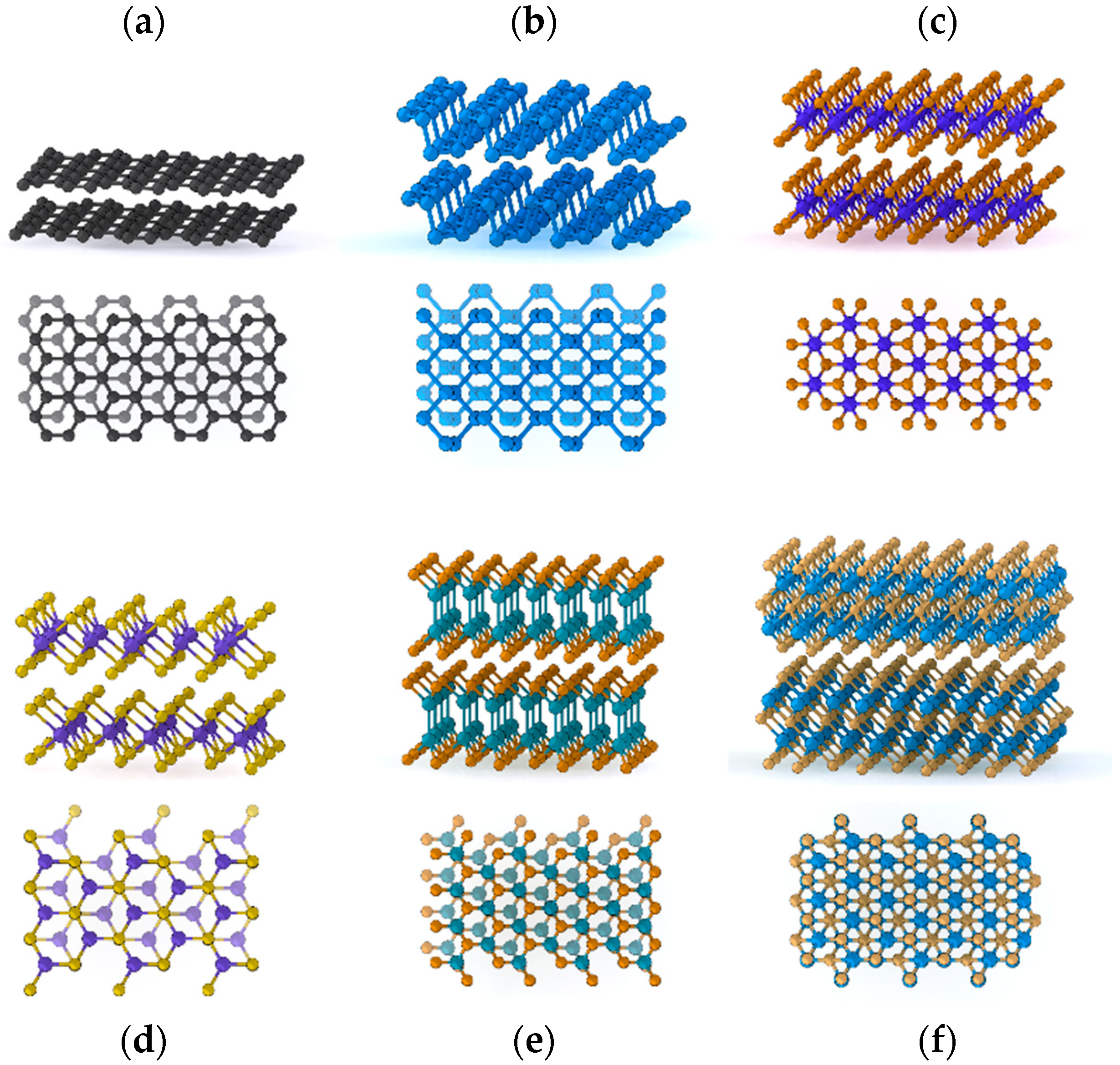
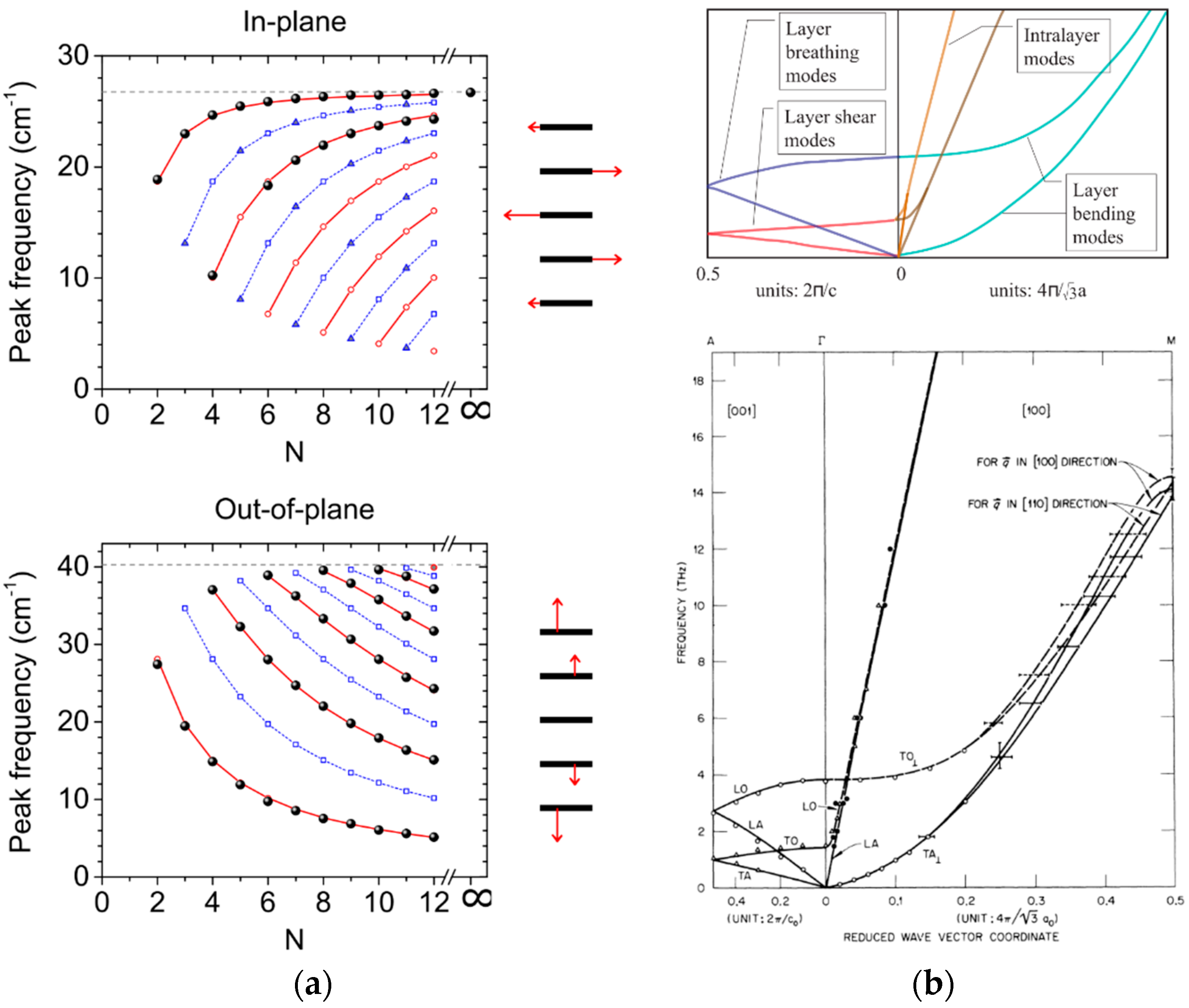
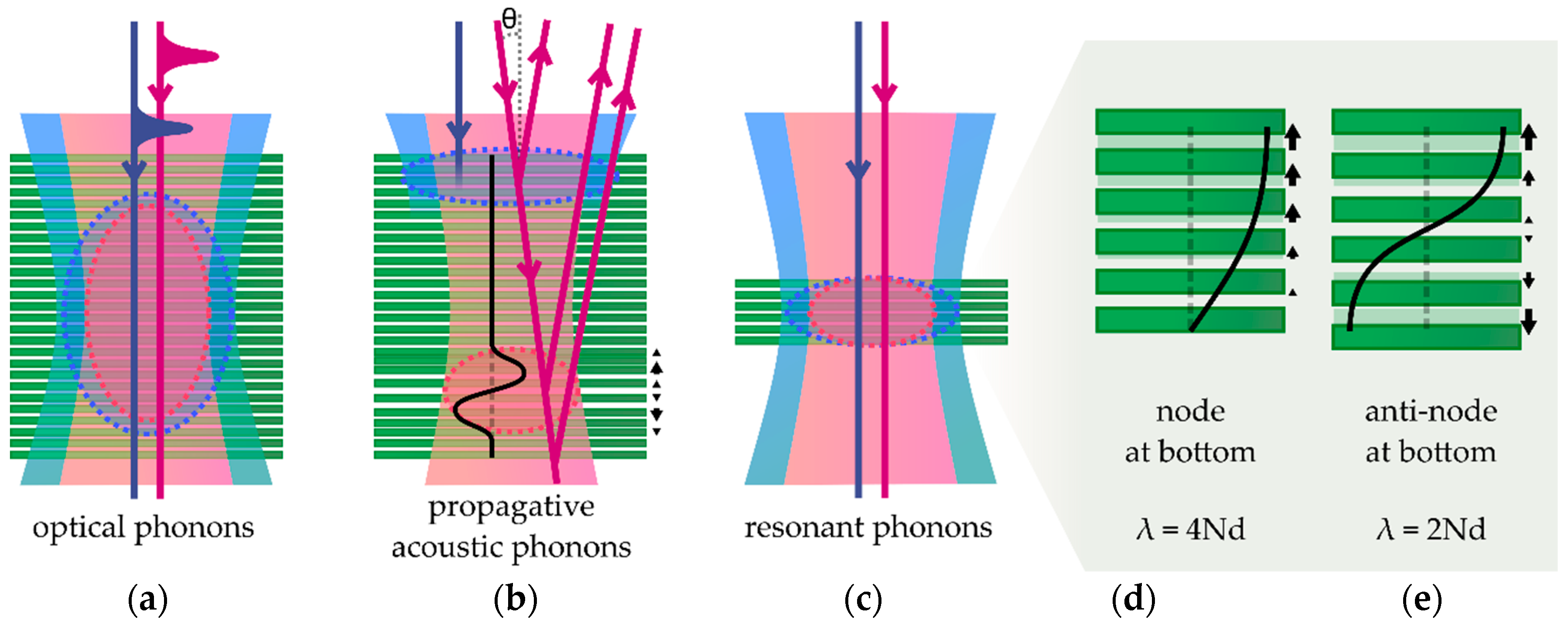

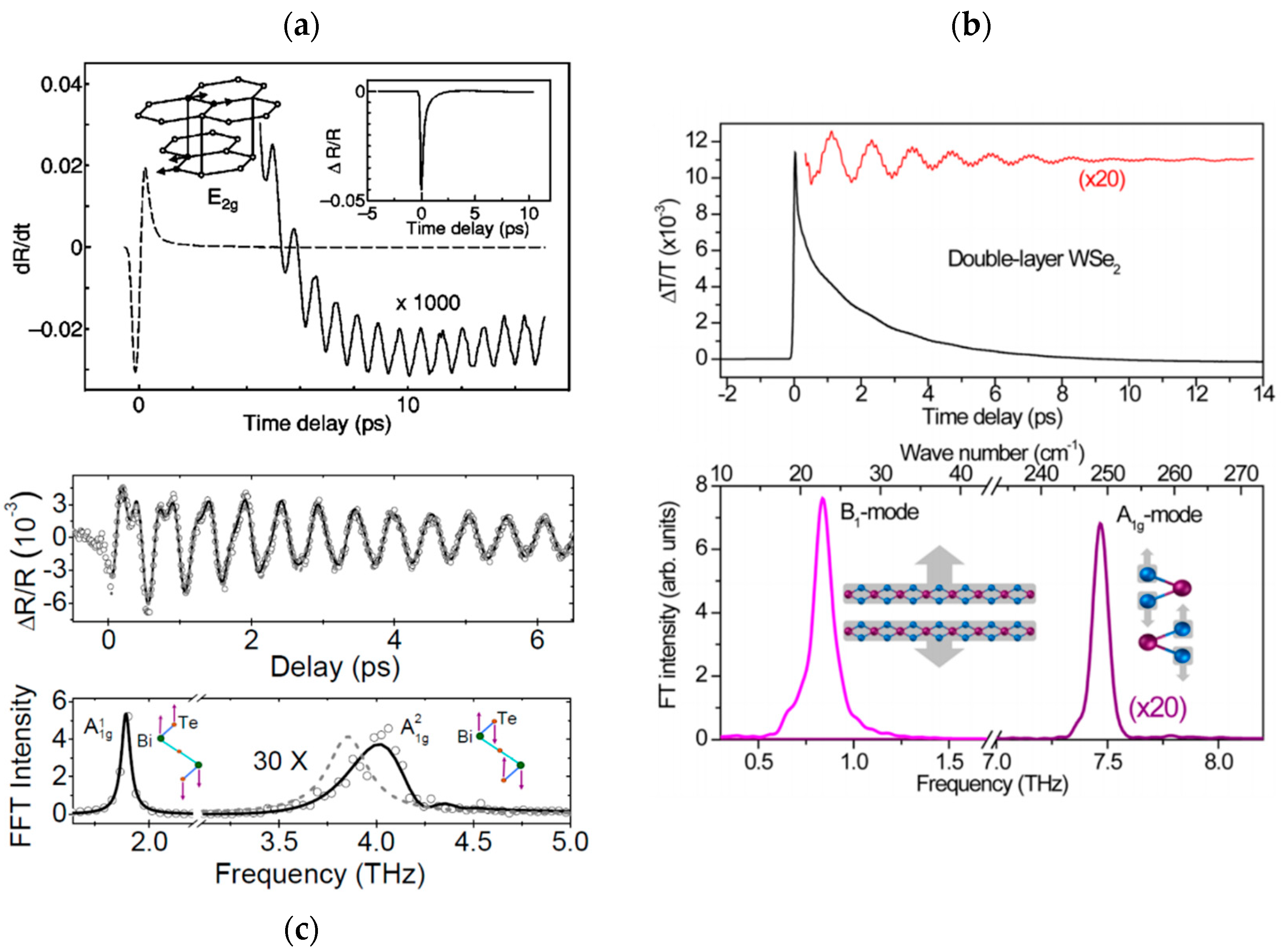
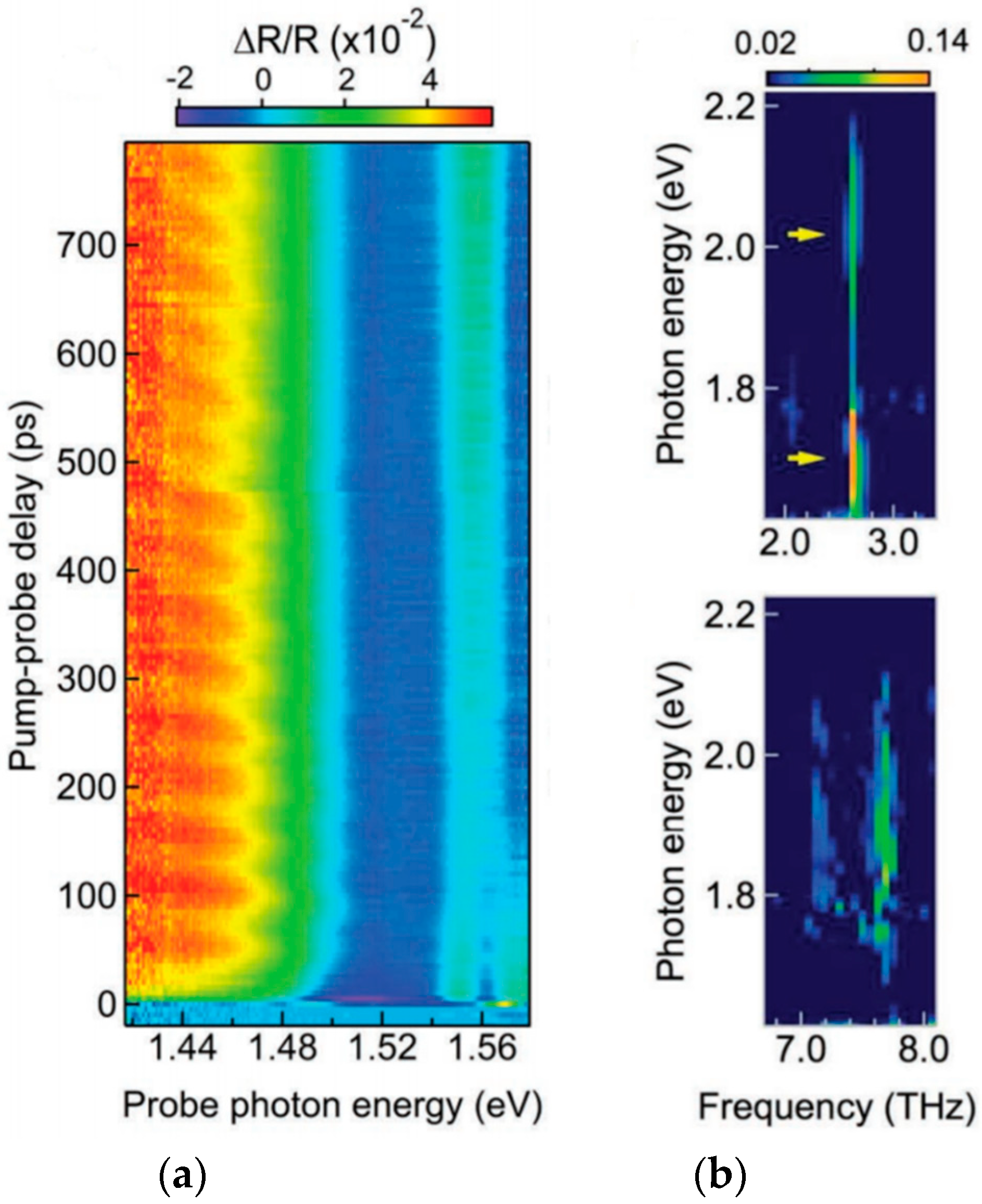
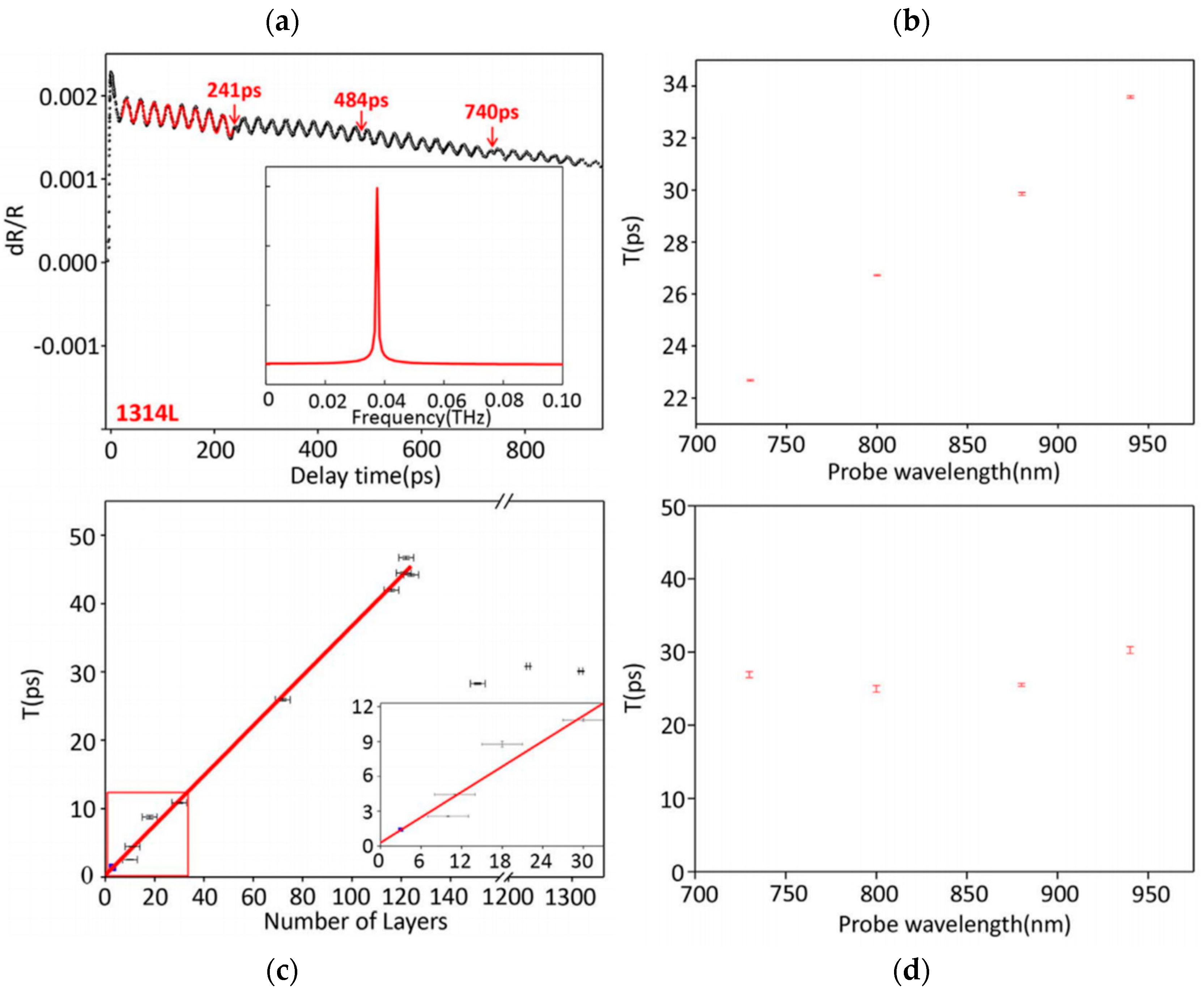
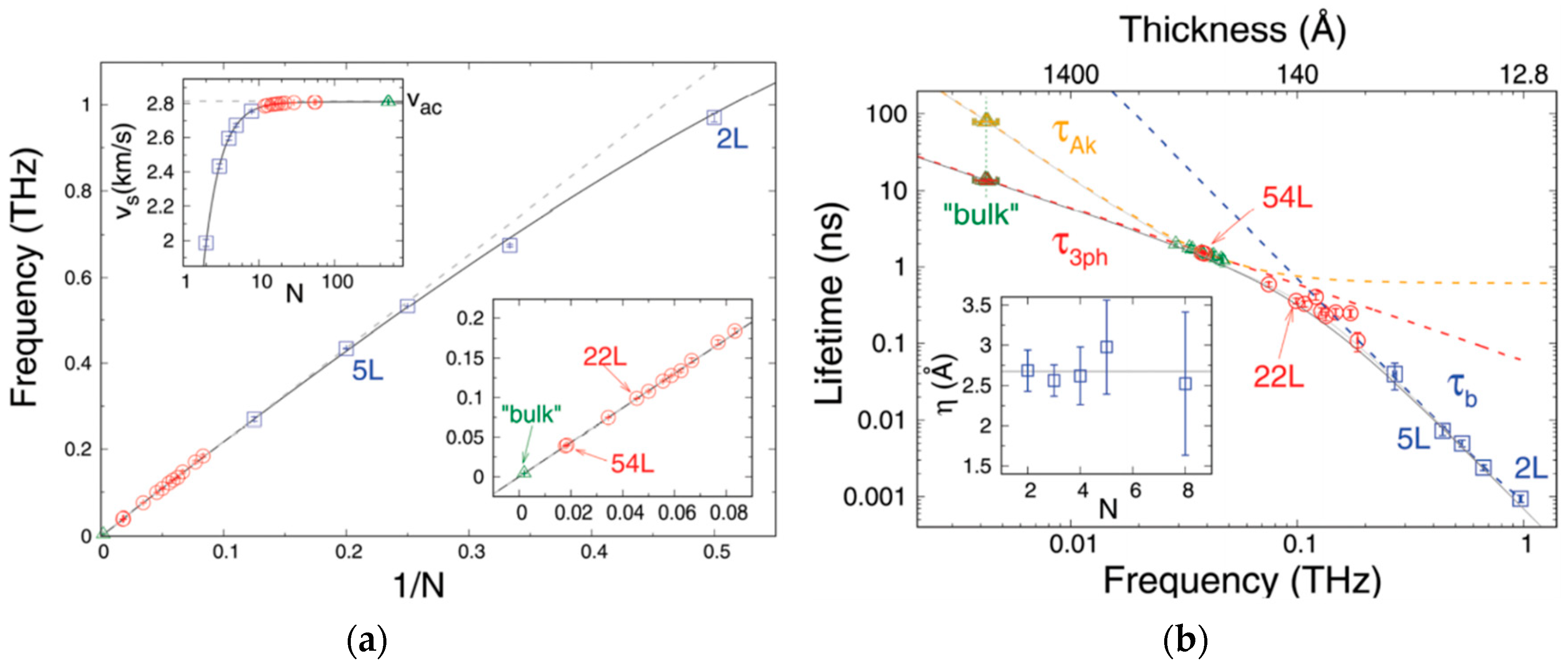
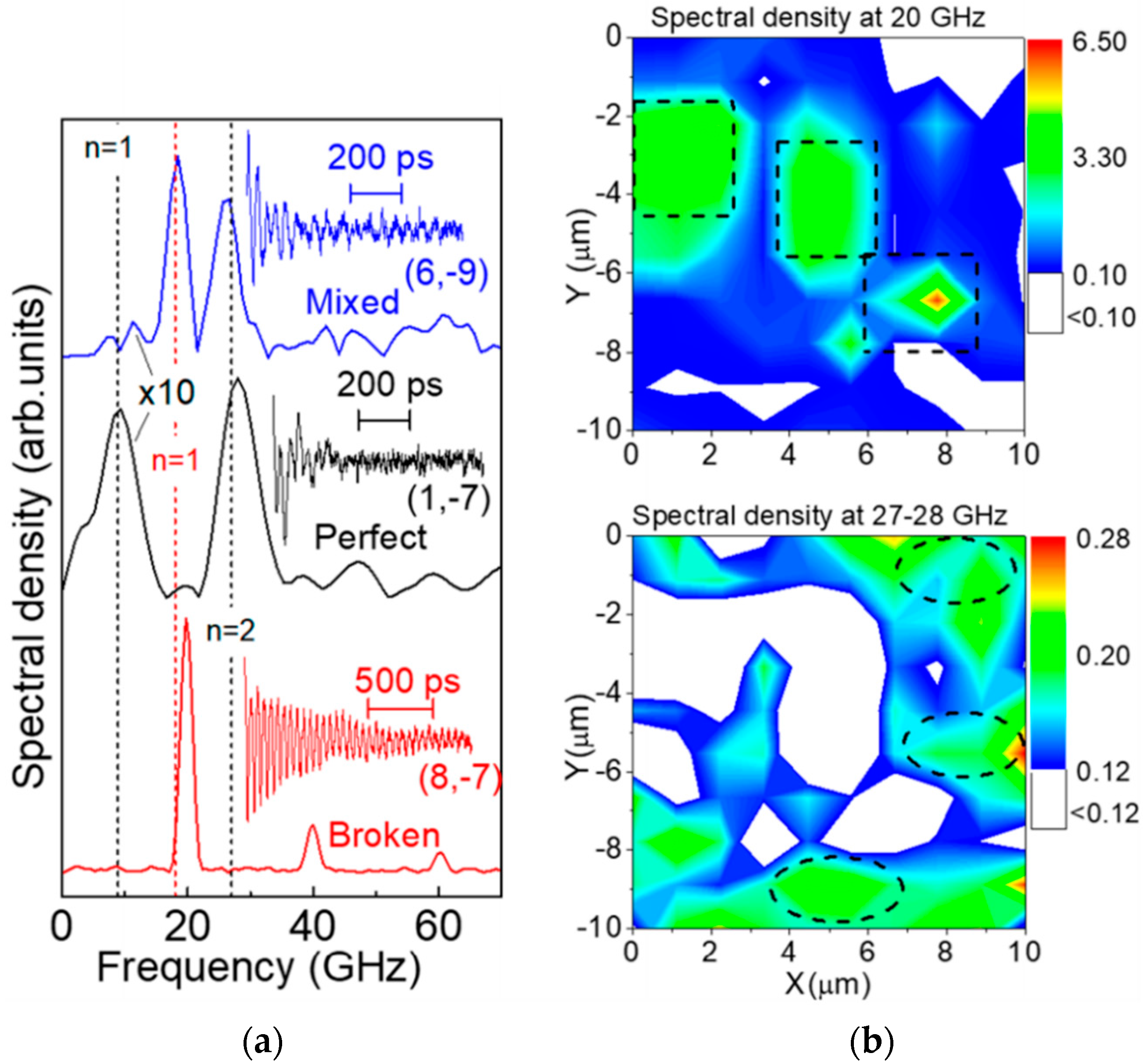
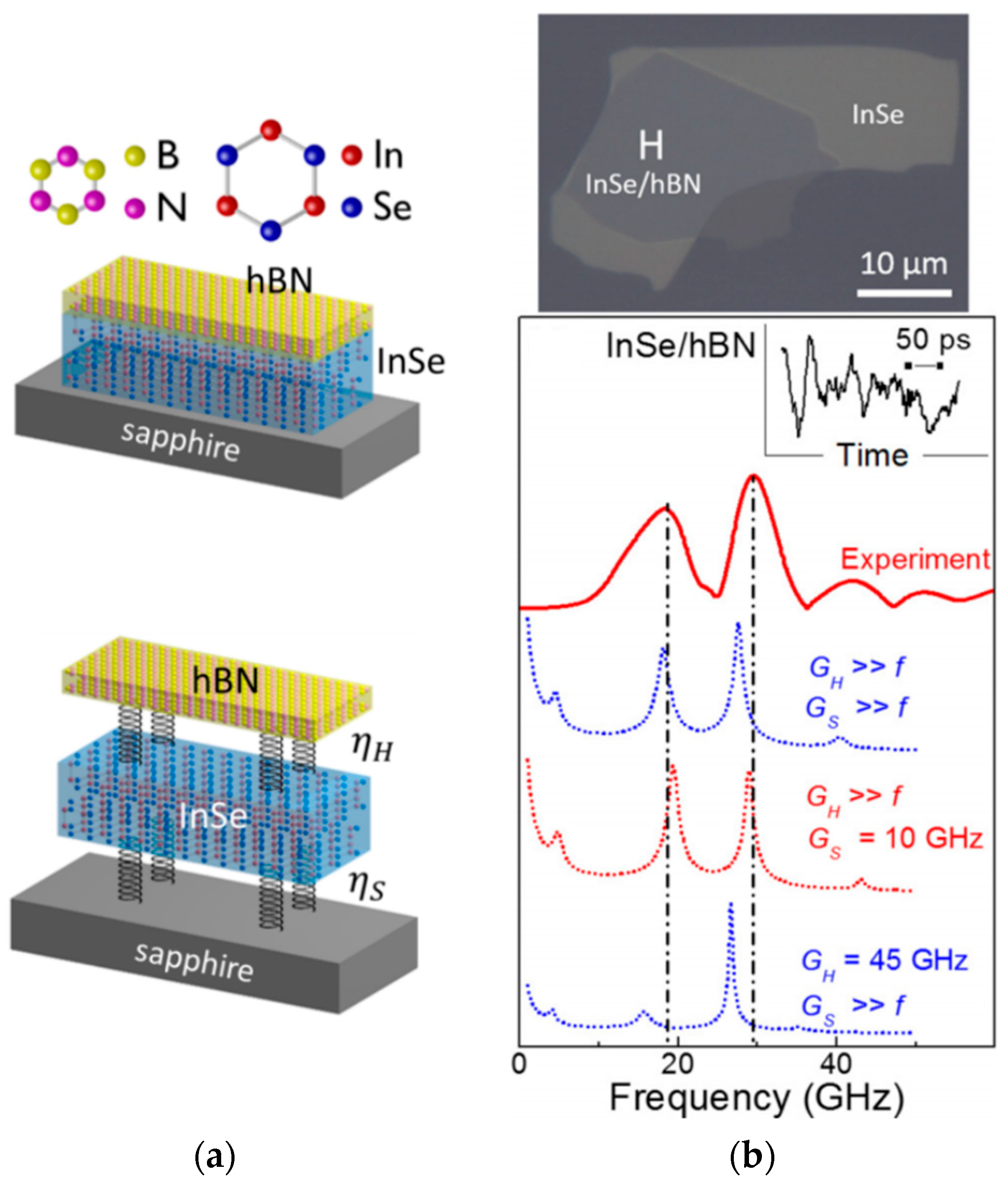
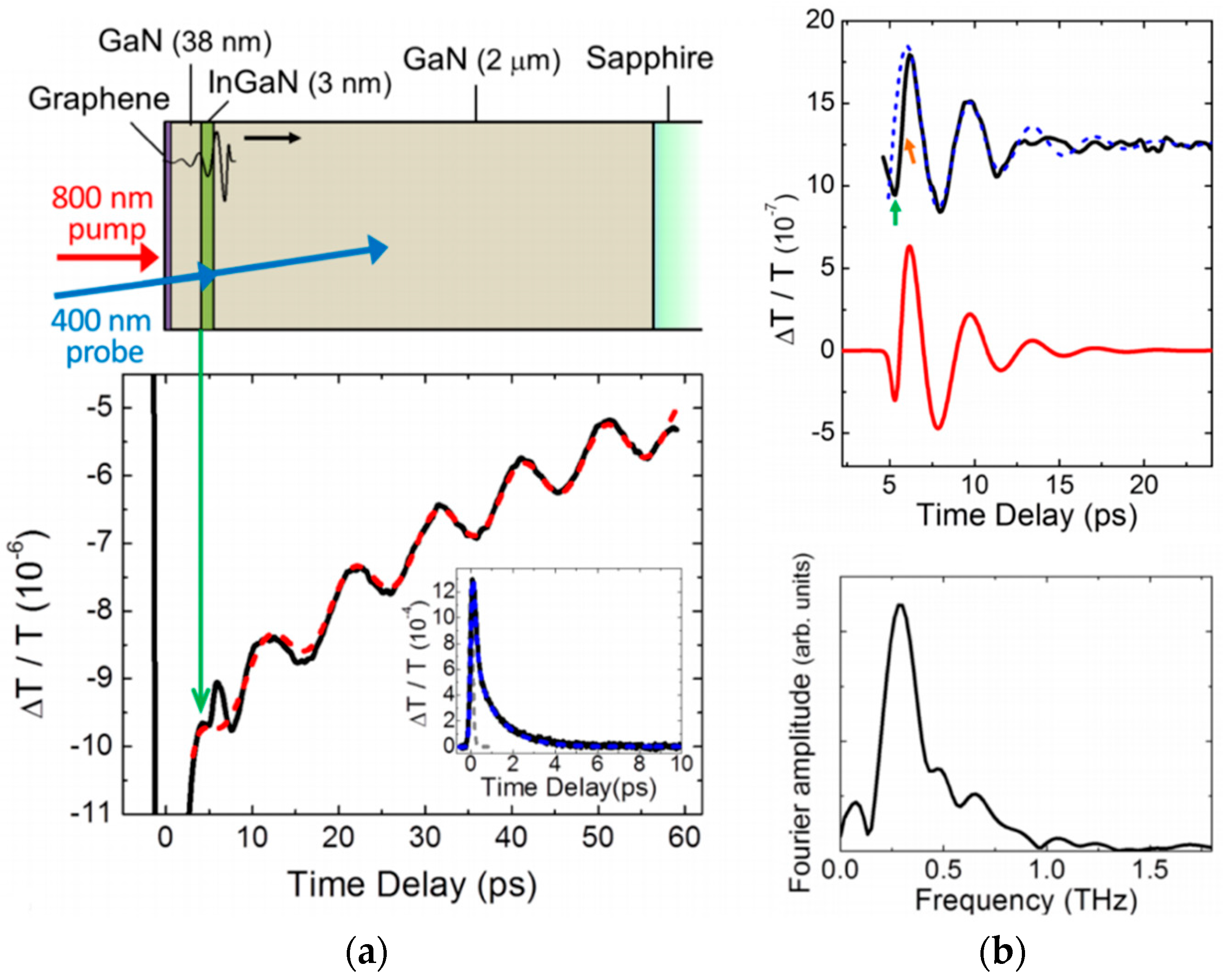
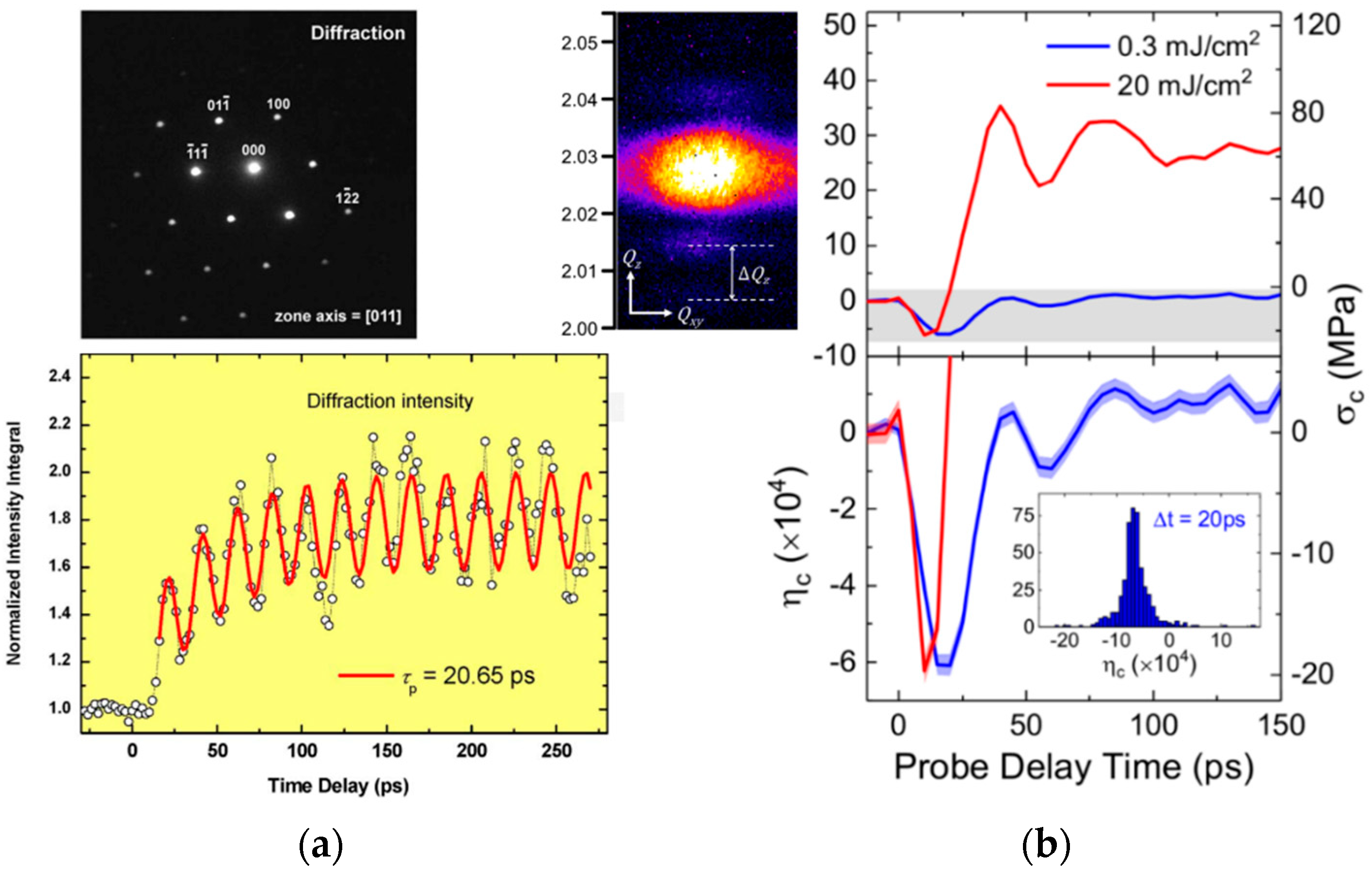
| Material | Layer Structure | µ (×10−6 kg/m2) | d (Å) | (×103 kg/m3) | vB (km/s) | K (×1019 N/m3) | C33 (GPa) | Z (×106 Pa.s/m) | Source |
|---|---|---|---|---|---|---|---|---|---|
| graphene | 1-atom | 0.76 | 3.4 | 2.3 | 4.0 | 11.0 | 37 | 9.2 | Neutron scattering [63] |
| 4.1 | 11.6 | 39 | 9.4 | X-ray [73] | |||||
| 4.0 | 10.9 | 37 | 9.1 | Ultrasound [108] | |||||
| 4.0 | 10.8 | 36 | 9.0 | T-D 1 EM 2 [124] | |||||
| hBN | 1-atom | 0.73 | 3.3 | 2.2 | 3.4 | 7.7 | 26 | 7.5 | X-ray [72] |
| BP | 2-atom | 1.4 | 5.3 | 2.7 | 5.3 | 14.4 | 76 | 14 | Propagative CAP [125] |
| 4.2 | 8.8 | 46 | 11 | RCP anti-node [126] | |||||
| 4.8 | 11.8 | 63 | 13 | Theory [127] | |||||
| 5.0 | 12.7 | 67 | 13 | Raman [128] | |||||
| 4.6 | 10.6 | 56 | 12 | Ultrasound [129] | |||||
| MoS2 | 3-atom | 3.1 | 6.2 | 5.1 | 3.5 | 10.1 | 62 | 18 | RCP anti-node 3 |
| trigonal | 3.2 | 8.5 | 52 | 16 | Neutron scattering [119] | ||||
| 3.2 | 8.6 | 53 | 16 | Raman [54] | |||||
| 2.9 | 6.9 | 43 | 15 | T-D 1 EM 2 [130] | |||||
| 2.5 | 5.1 | 32 | 13 | T-D 1 X-ray [131] | |||||
| MoSe2 | 3-atom | 4.5 | 6.5 | 6.9 | 2.8 | 8.5 | 55 | 19 | RCP anti-node [132] |
| trigonal | 2.9 | 9.3 | 60 | 20 | Raman [44] | ||||
| MoTe2 | 3-atom | 5.3 | 6.9 | 7.7 | 2.6 | 7.8 | 54 | 20 | Raman [52] |
| trigonal | |||||||||
| WSe2 | 3-atom | 6.0 | 6.5 | 9.3 | 2.5 | 9.0 | 58 | 23 | RCP anti-node [133] |
| trigonal | 2.4 | 8.6 | 56 | 23 | Raman [54] | ||||
| PtSe2 | 3-atom octahedral | 4.8 | 5.0 | 9.5 | 1.7 | 5.6 | 28 | 16 | RCP node [134] |
| 1.8 | 6.1 | 31 | 17 | RCP anti-node [134] | |||||
| 1.6 | 5.1 | 26 | 16 | Raman [44] | |||||
| GaS | 4-atom | 0.76 | 7.7 | 3.9 | 3.1 | 4.9 | 38 | 12 | Brillouin spectroscopy [99] |
| InSe | 4-atom | 4.6 | 8.3 | 5.5 | 2.5 | 4.1 | 34 | 14 | RCP node & anti-node [135,136,137] |
| 2.6 | 4.3 | 36 | 14 | Ultrasound [109] | |||||
| Bi2Se3 | 5-atom | 7.3 | 9.5 | 7.7 | 2.0 | 3.2 | 31 | 15 | Propagative CAP [39] |
| Bi2Te3 | 5-atom | 7.8 | 10.2 | 7.6 | 2.6 | 5.1 | 52 | 20 | Propagative CAP [138] |
| 2.5 | 4.6 | 46 | 19 | RCP node [139] | |||||
| 2.5 | 4.7 | 48 | 19 | Ultrasound [140] | |||||
| 2.6 | 5.0 | 51 | 20 | Neutron scattering [141] | |||||
| Re6Se8Cl2 | clustered | 6.9 | 9.1 | 7.6 | 2.7 | 6.1 | 55 | 21 | Propagative CAP [142] |
| 1.2 | Propagative CAP (shear) [142] | ||||||||
| Al | 2.7 | 6.4 | 111 | 17 | |||||
| Sapphire | 4.0 | 11.0 | 484 | 44 | |||||
| Quartz | 2.6 | 5.6 | 81 | 14 | |||||
| Fused silica | 2.2 | 6.0 | 78 | 13 | |||||
| (100)Si | 2.2 | 8.4 | 155 | 18 |
Publisher’s Note: MDPI stays neutral with regard to jurisdictional claims in published maps and institutional affiliations. |
© 2020 by the authors. Licensee MDPI, Basel, Switzerland. This article is an open access article distributed under the terms and conditions of the Creative Commons Attribution (CC BY) license (http://creativecommons.org/licenses/by/4.0/).
Share and Cite
Vialla, F.; Fatti, N.D. Time-Domain Investigations of Coherent Phonons in van der Waals Thin Films. Nanomaterials 2020, 10, 2543. https://doi.org/10.3390/nano10122543
Vialla F, Fatti ND. Time-Domain Investigations of Coherent Phonons in van der Waals Thin Films. Nanomaterials. 2020; 10(12):2543. https://doi.org/10.3390/nano10122543
Chicago/Turabian StyleVialla, Fabien, and Natalia Del Fatti. 2020. "Time-Domain Investigations of Coherent Phonons in van der Waals Thin Films" Nanomaterials 10, no. 12: 2543. https://doi.org/10.3390/nano10122543
APA StyleVialla, F., & Fatti, N. D. (2020). Time-Domain Investigations of Coherent Phonons in van der Waals Thin Films. Nanomaterials, 10(12), 2543. https://doi.org/10.3390/nano10122543




